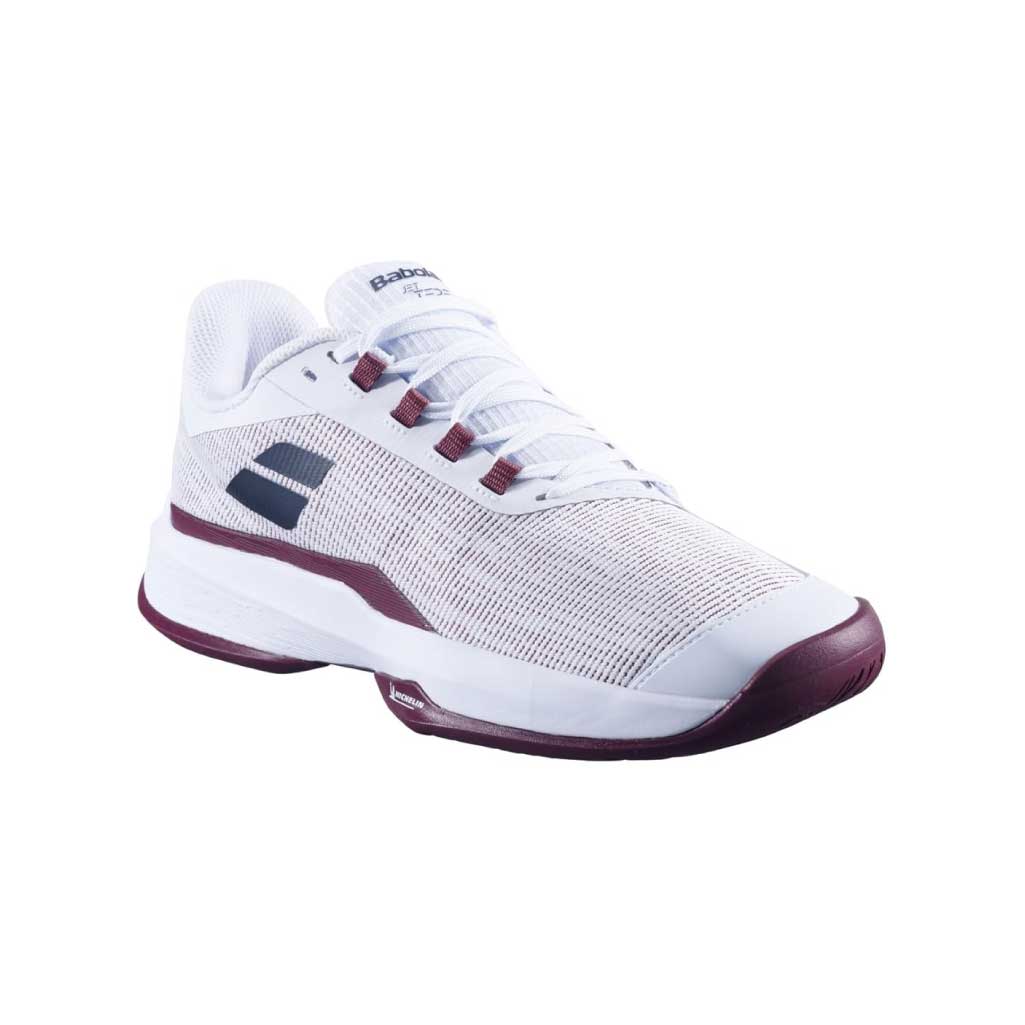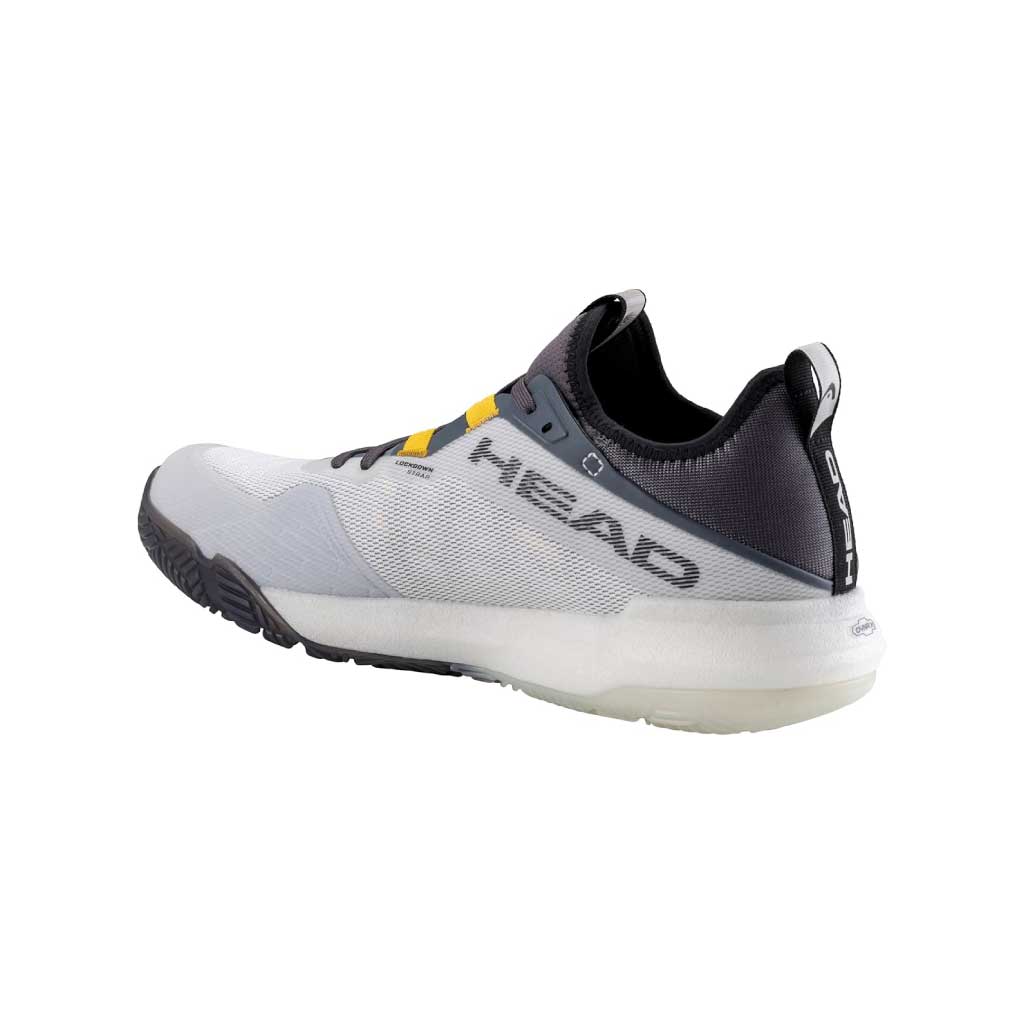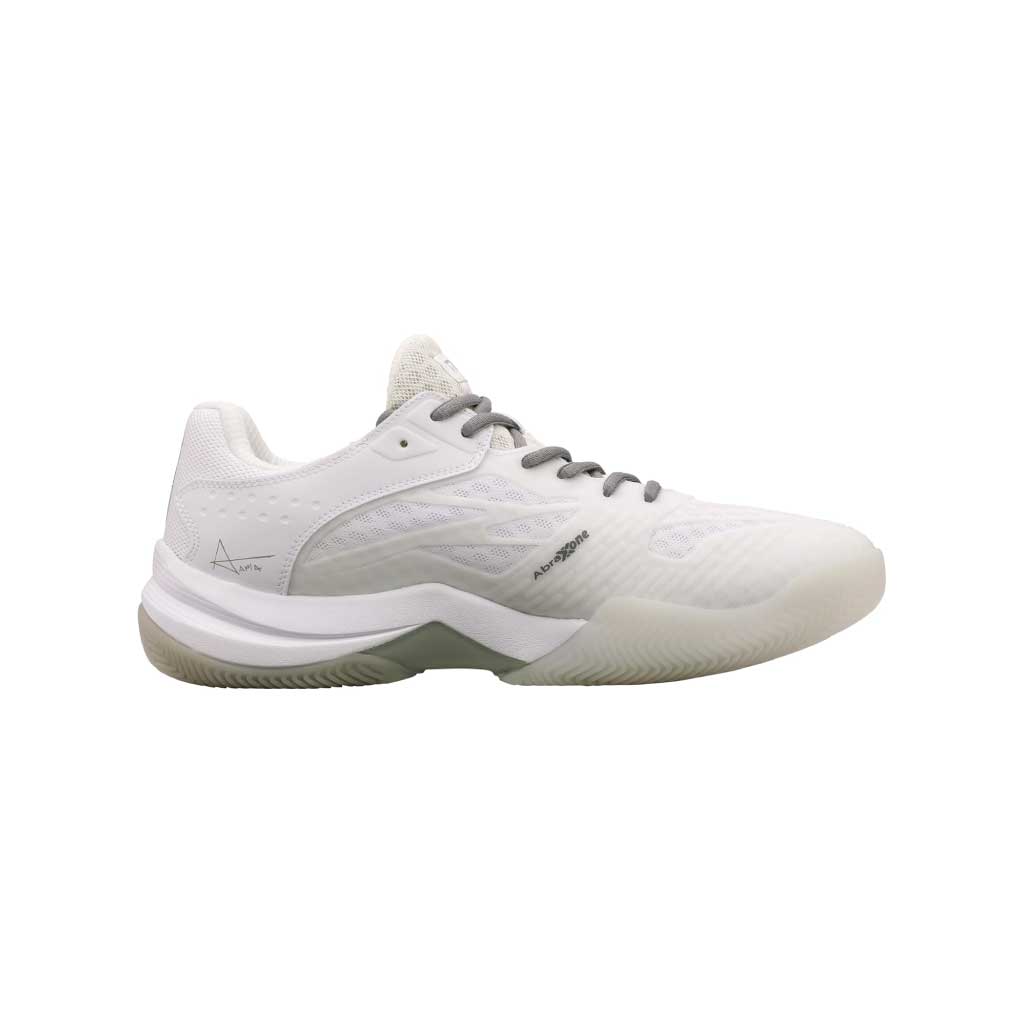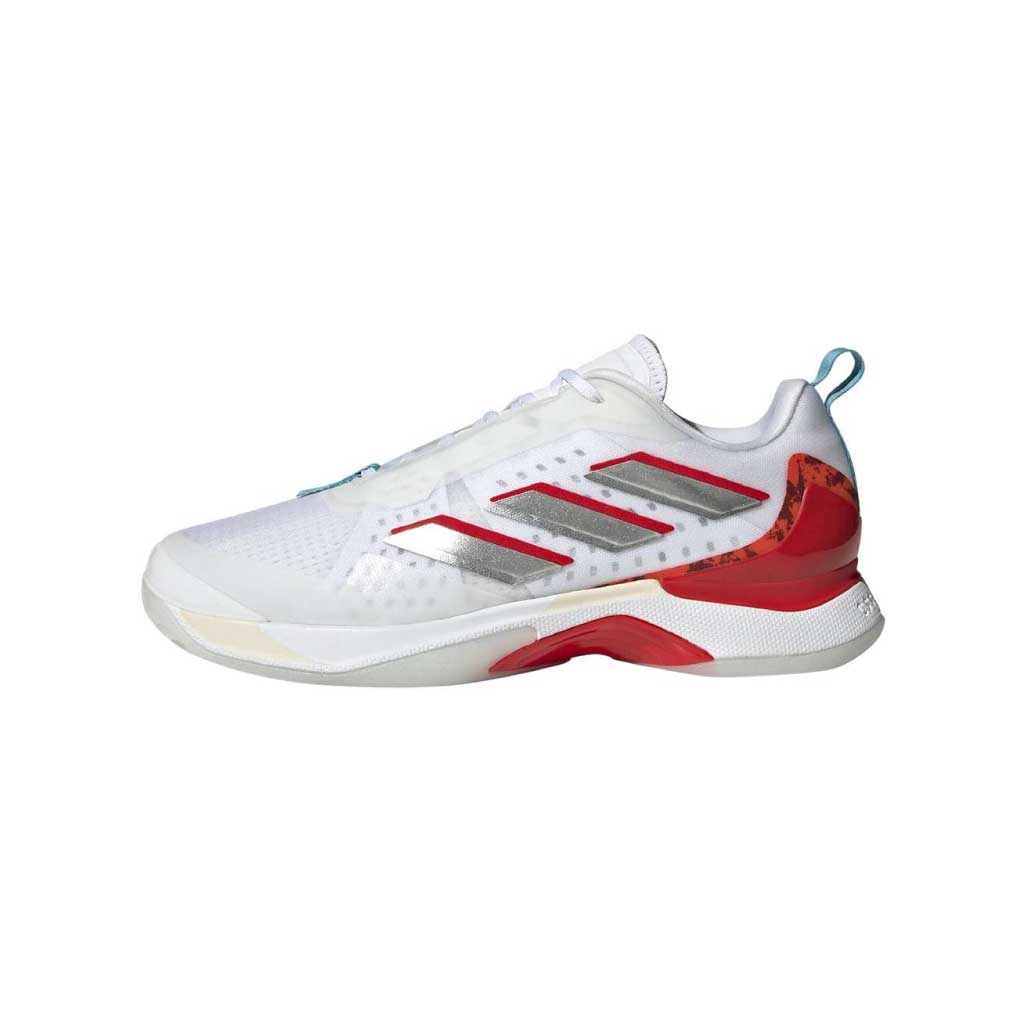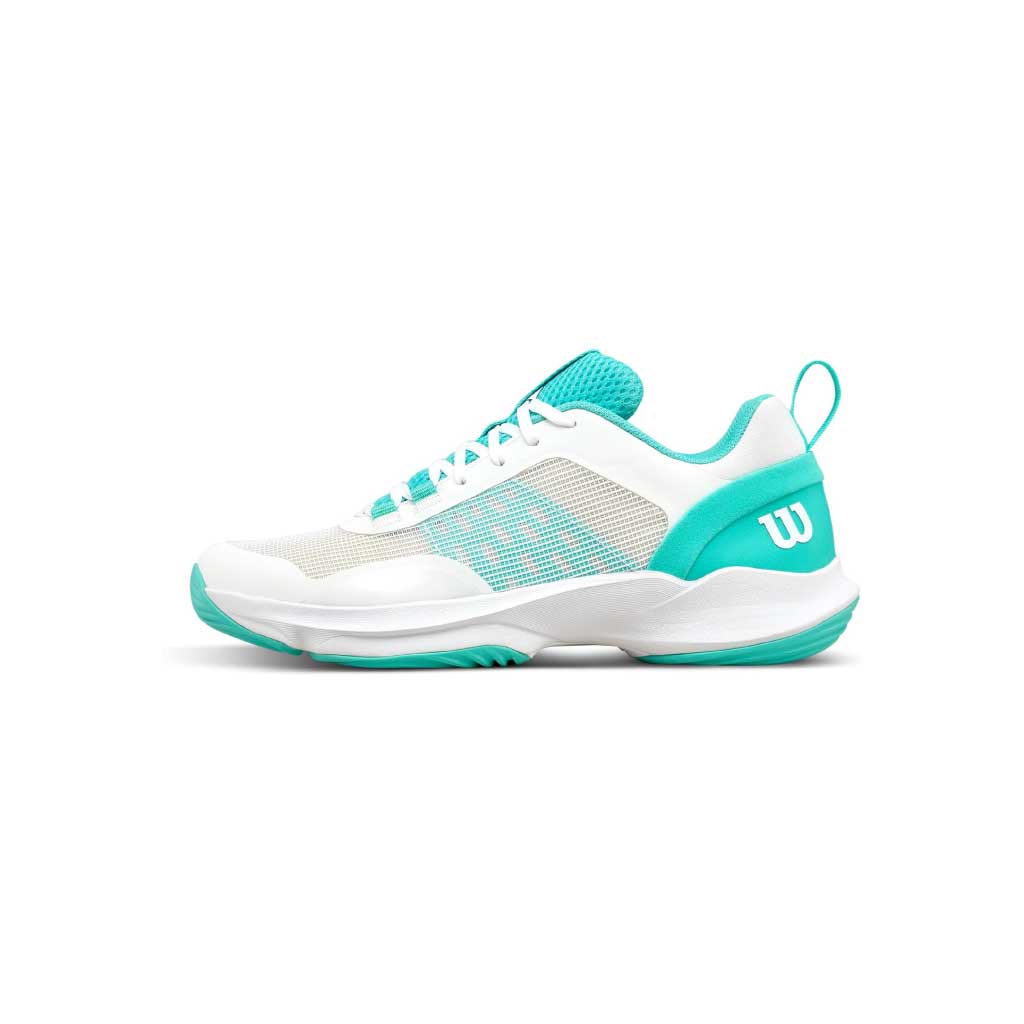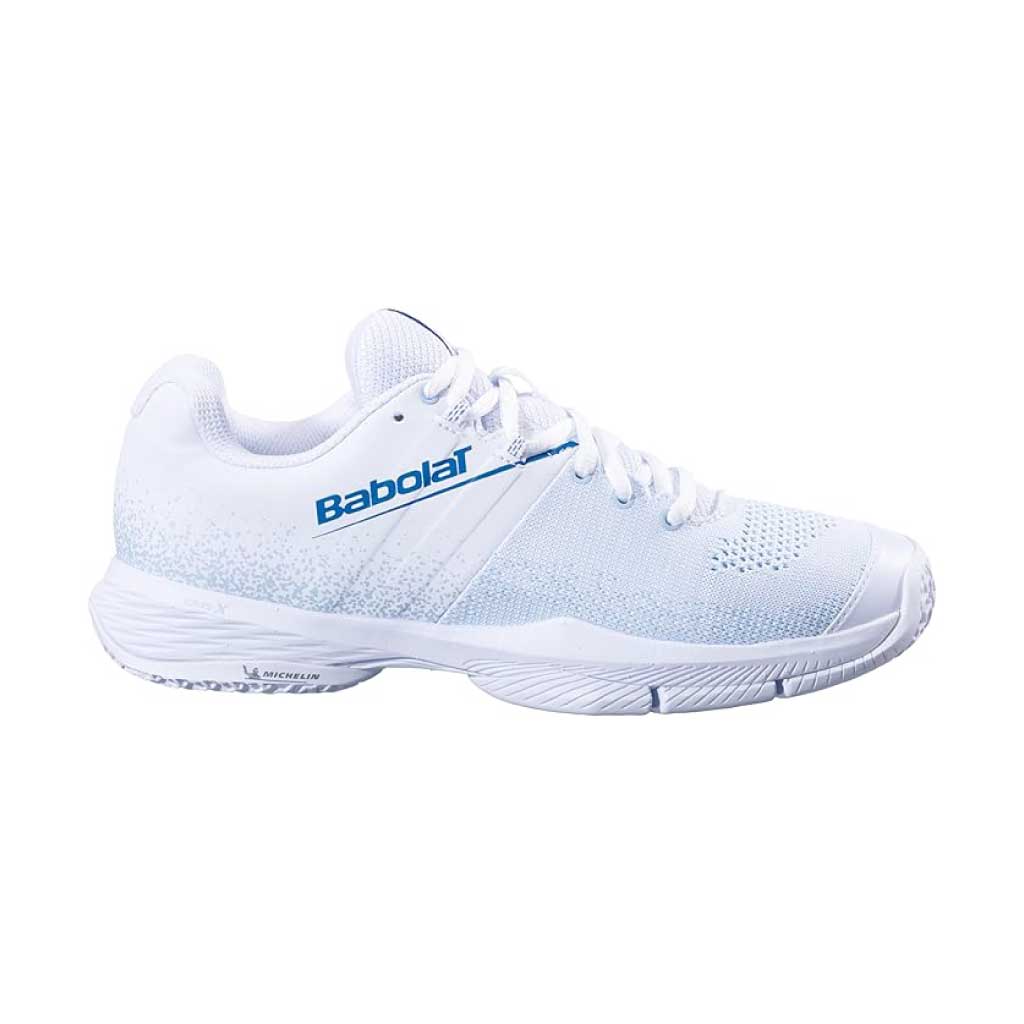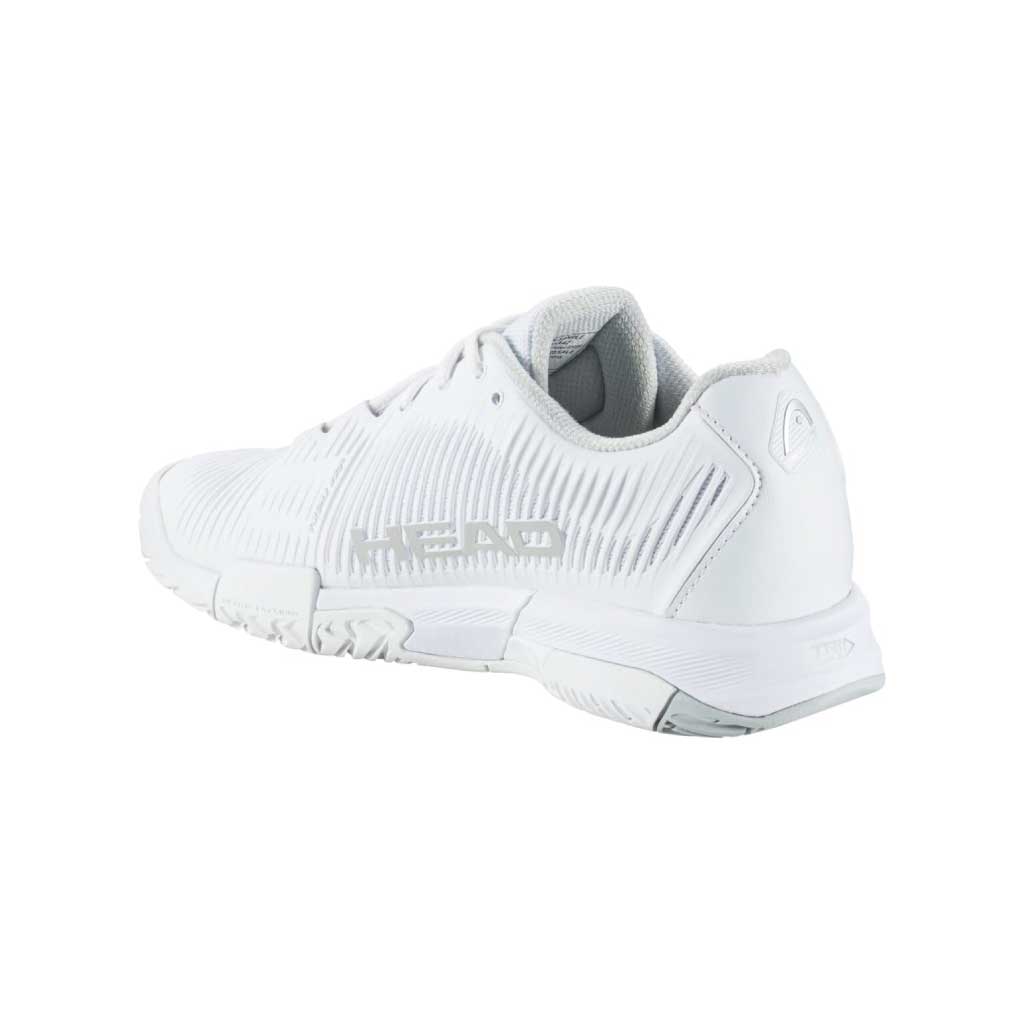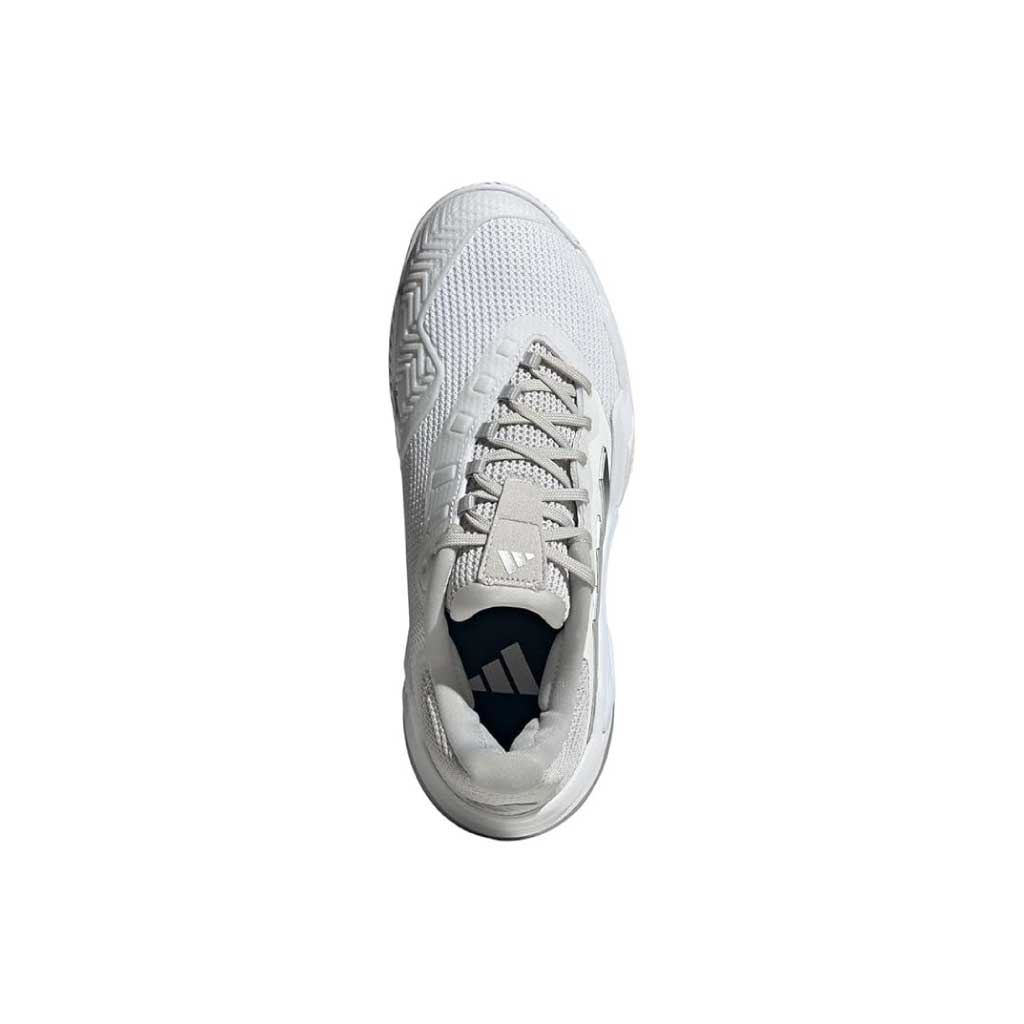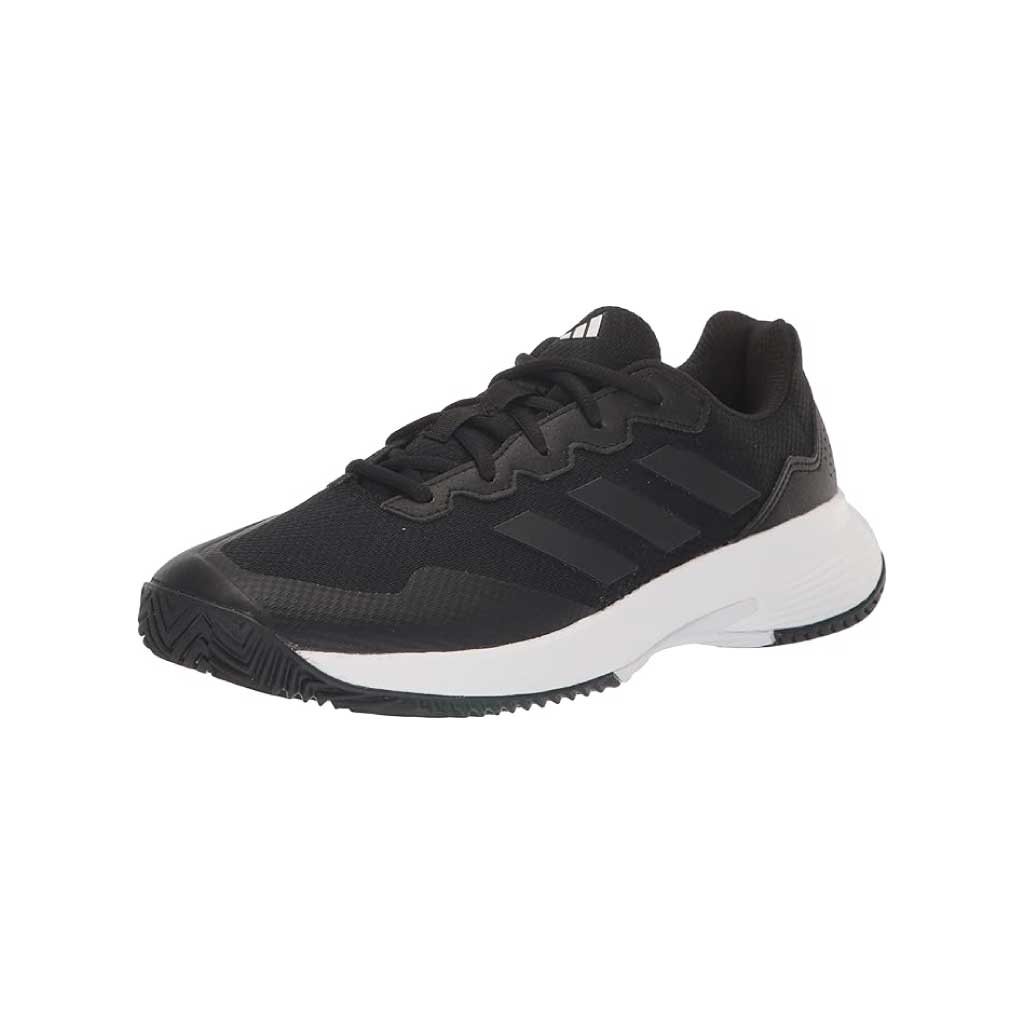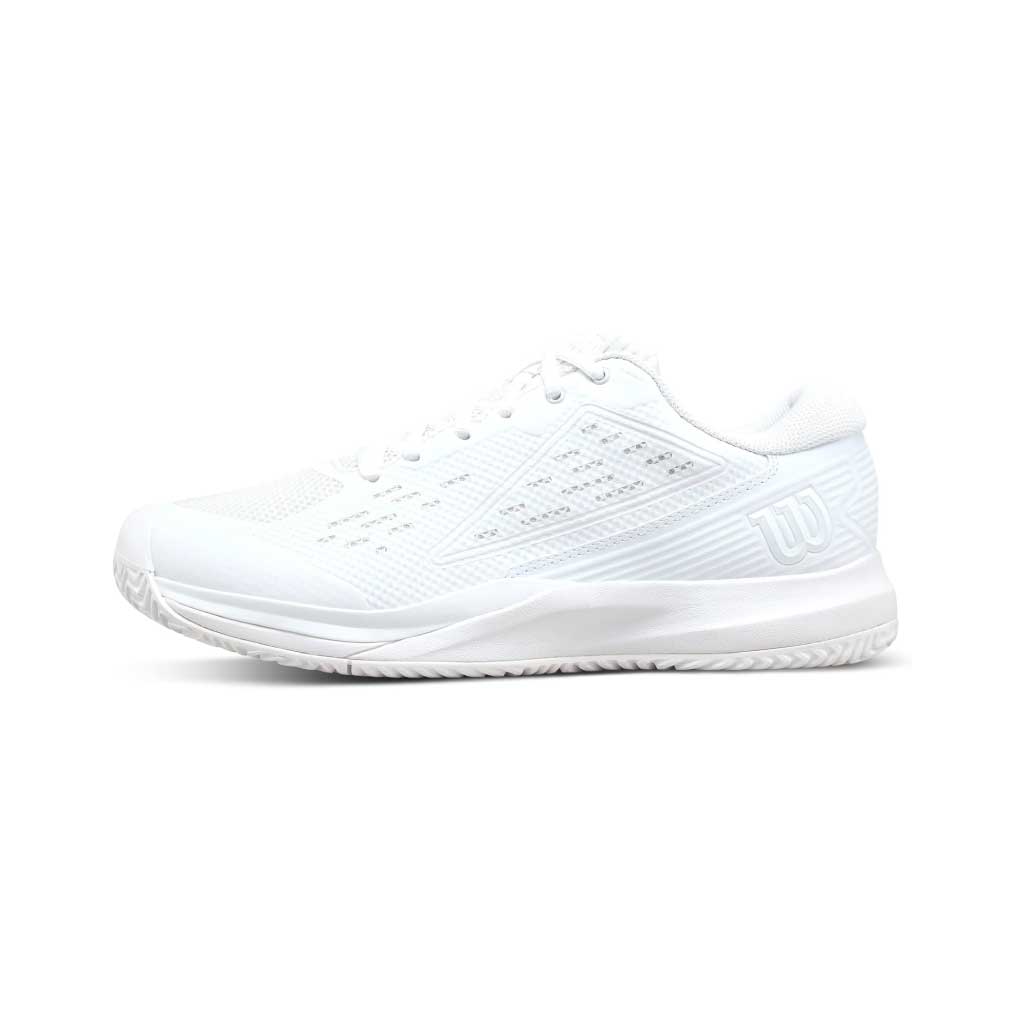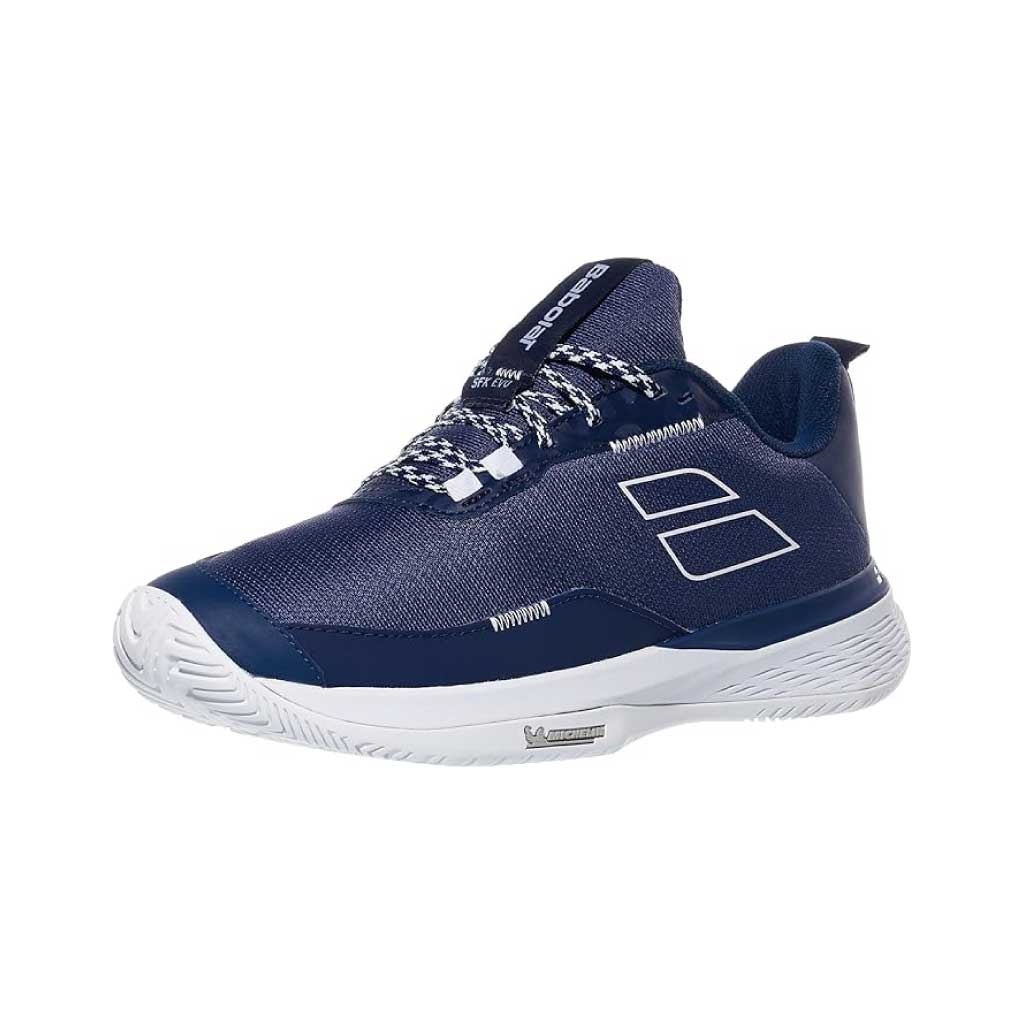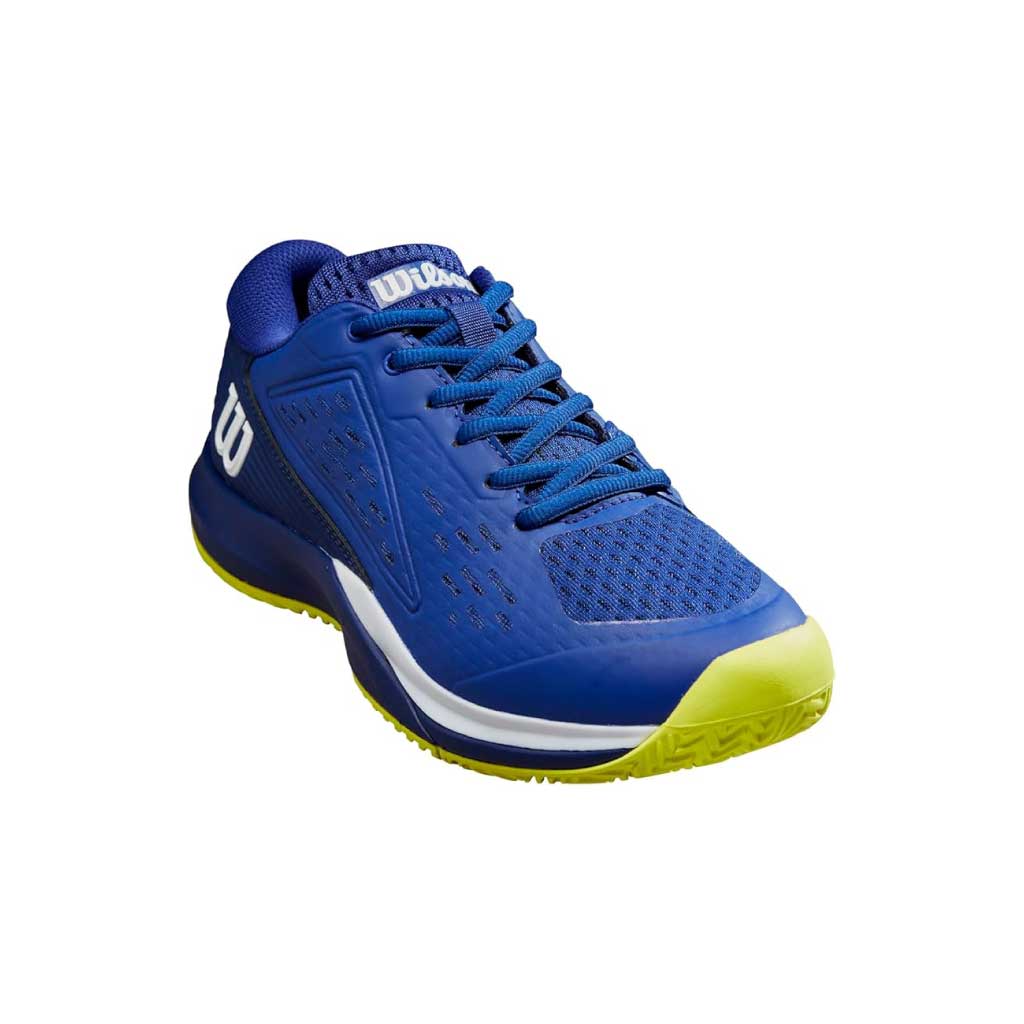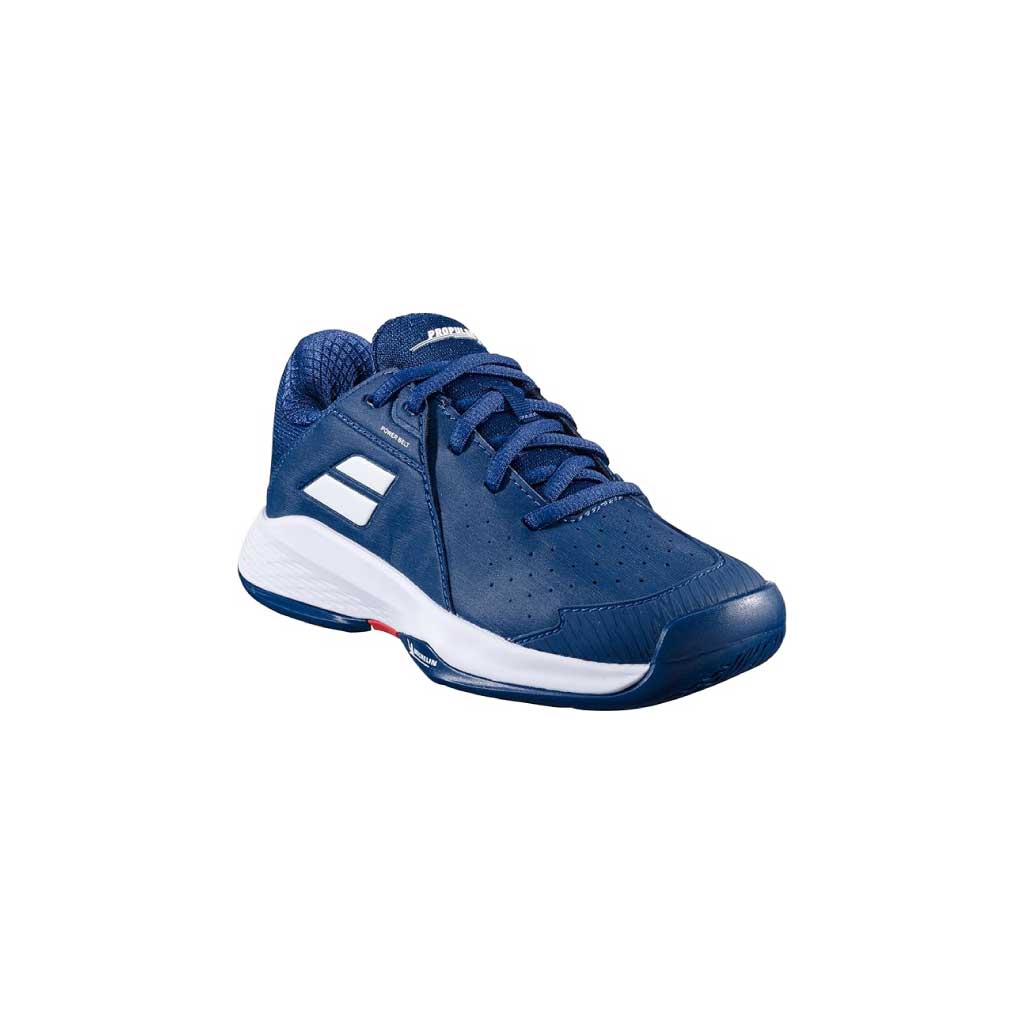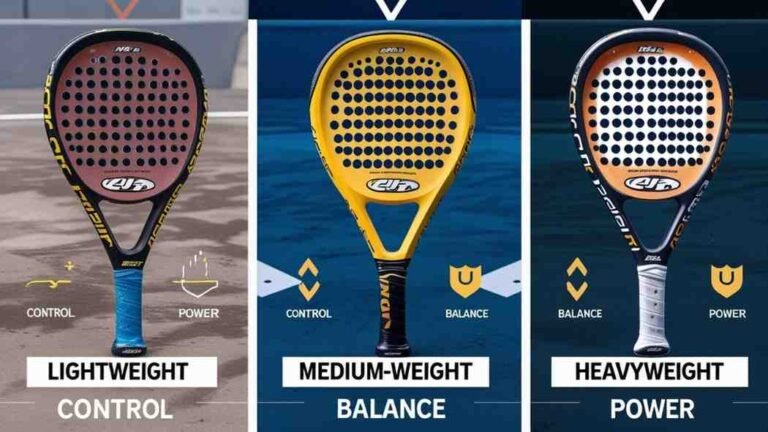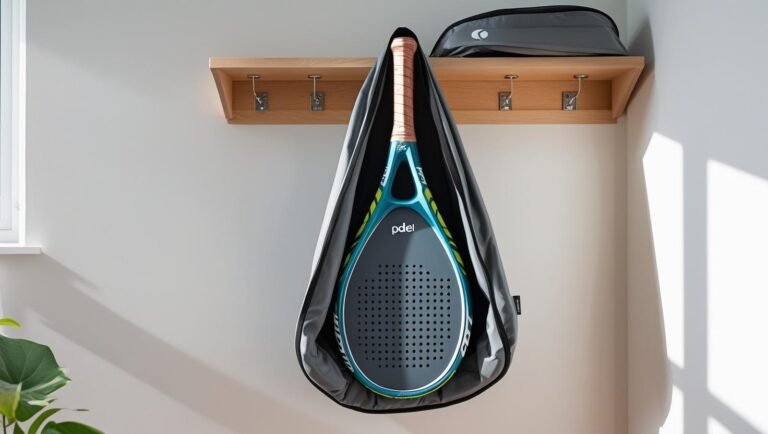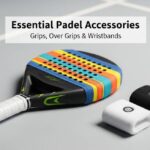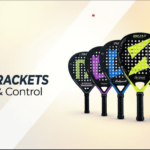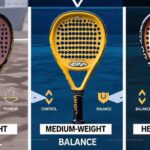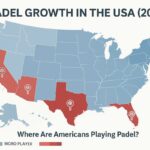Want a shortcut? Take a quiz and find your perfect Padel Racket in 30 secs.
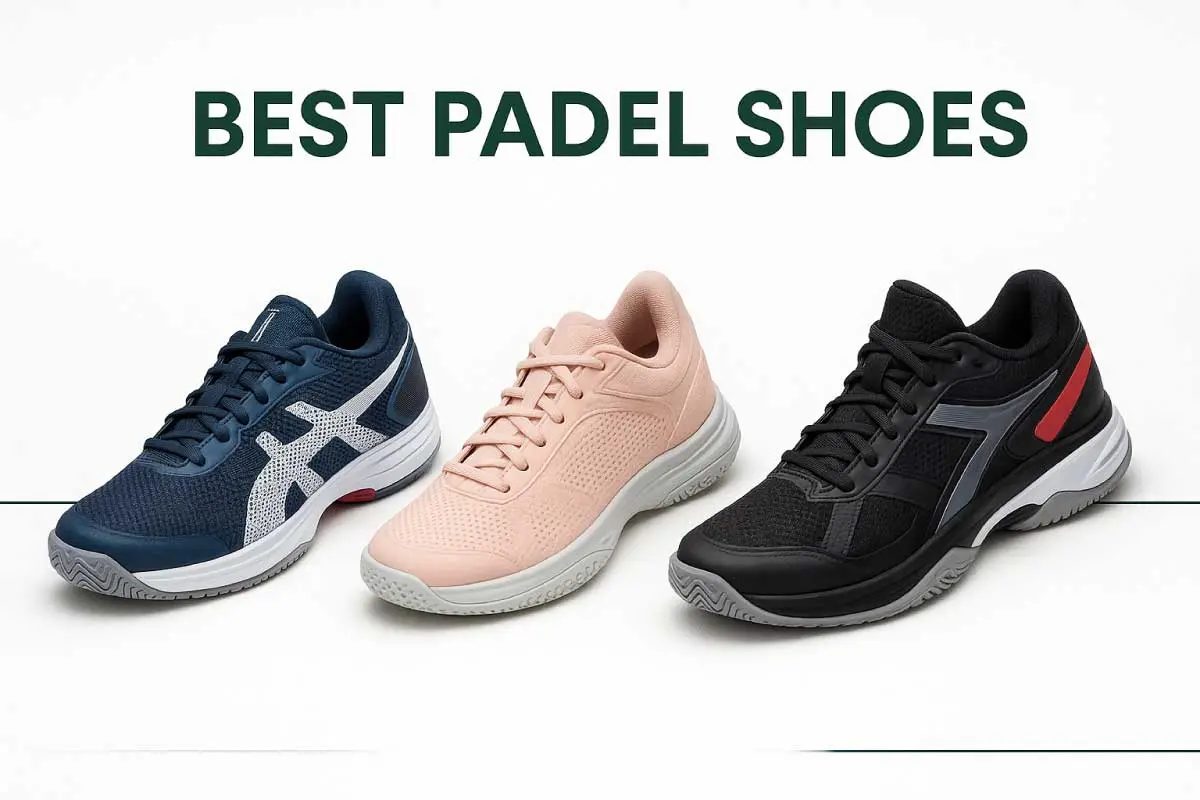
Best Padel Shoes 2026: Top Picks for Grip & Comfort
The best padel shoes in 2026 offer you grip, stability, and cushioning, enabling you to move quickly and safely on the court. They use patterned soles for traction, reinforced sides for ankle support, and midsoles that soften landings while keeping you quick. These features prevent slips and protect joints during fast rallies.
This guide showcases the top men’s, women’s, kids’, and budget-friendly padel shoes of 2026. You’ll also learn how soles work on different courts, how to fit your shoes, and which models suit beginners or competitive players. Keep reading to find the pair that matches your game.
Listen: Your 2-Minute Guide to the Best Padel Shoes 2026
Best Padel Shoes 2026 — Quick Picks
The best padel shoes in 2026 strike a balance between traction, comfort, and durability across men’s, women’s, kids’, and budget models. Top picks include Adidas, Wilson, Babolat, Head, and Nox. Each shoe below highlights its key strength so you can choose fast.
Best Men’s Padel Shoes
- Adidas Crazyquick Boost Padel Sneaker — Best overall. Responsive Boost midsole keeps you light and cushioned. Check price on Amazon
- Wilson Bela Pro Padel Shoes — Best stability. Reinforced sidewalls protect ankles on quick cuts. View specs
- Babolat Jet Tere 2 All Court — Best lightweight feel. Smooth transitions and breathable upper. Check price
- Head Motion Pro Padel Shoe — Best lateral support. Wide base for secure side steps. View specs
- Nox AT10 LUX — Best for joint comfort. Clinically designed cushioning reduces knee stress. Check price
Best Women’s Padel Shoes
- Adidas Avacourt Tennis Shoe — Best overall. Built for women’s foot shape with steady support. Check price
- Wilson Hurakn Pro V2 Women — Best ankle support. High-collar fit keeps ankles stable. View specs
- Babolat Sensa Women’s Padel Shoe — Best breathable mesh. Light and airy for long matches. Check price
- Head Revolt Pro Women’s Sneaker — Best durability. Reinforced upper lasts through heavy play. View specs
- Adidas Barricade 13 Women’s Sneaker — Best control. Stable frame for sharp stops and turns. Check price
Best Budget Padel Shoes Under $100
- Adidas Gamecourt 2 Men’s Sneaker — Best entry-level. Affordable grip and comfort for new players. Check price
- Wilson Rush Pro Ace — Best value comfort. Soft cushioning and balanced support. View specs
- Babolat SFX Evo — Best budget cushioning. Plush feel without high cost. Check price
Best Kids’ Padel Shoes
- Wilson Rush Pro Ace Junior — Best all-rounder. Lightweight build with steady traction. Check price
- Babolat Propulse Junior 3 — Best durability. Reinforced upper and secure fit for active kids. View specs
Compare the Best Padel Shoes 2026
Here’s a quick comparison of the best padel shoes of 2026. Use this table to see the sole type, fit, weight feel, and best use case. Tap a shoe name to jump back to its full review in Quick Picks.
| Model | Sole Type | Fit | Weight Feel | Best For | Link |
|---|---|---|---|---|---|
| Adidas Crazyquick Boost | Hybrid (Boost midsole) | Regular | Light & responsive | All-rounders | Jump to Men’s Picks |
| Wilson Bela Pro | Herringbone | Narrow–Regular | Firm & stable | Aggressive net players | Jump to Men’s Picks |
| Babolat Jet Tere 2 | Omni | Regular | Ultra-light | Counter-defenders | Jump to Men’s Picks |
| Head Motion Pro | Hybrid | Wide | Medium | Lateral movers | Jump to Men’s Picks |
| Nox AT10 LUX | Herringbone | Regular | Cushioned | Joint comfort | Jump to Men’s Picks |
| Adidas Avacourt | Herringbone | Narrow | Light | Women’s all-rounder | Jump to Women’s Picks |
| Wilson Hurakn Pro V2 Women | Hybrid | Regular | Medium | Ankle support | Jump to Women’s Picks |
| Babolat Sensa Women | Omni | Narrow–Regular | Light | Breathability | Jump to Women’s Picks |
| Head Revolt Pro Women | Hybrid | Regular | Medium | Durability | Jump to Women’s Picks |
| Adidas Barricade 13 Women | Herringbone | Narrow | Firm | Control | Jump to Women’s Picks |
| Adidas Gamecourt 2 | Omni | Regular | Light | Beginners | Jump to Budget Picks |
| Wilson Rush Pro Ace | Hybrid | Regular–Wide | Medium | Value buyers | Jump to Budget Picks |
| Babolat SFX Evo | Hybrid | Wide | Cushioned | Budget comfort | Jump to Budget Picks |
| Wilson Rush Pro Ace Junior | Omni | Regular | Light | Kids | Jump to Kids’ Picks |
| Babolat Propulse Junior 3 | Hybrid | Regular–Wide | Medium | Kids durability | Jump to Kids’ Picks |
After reviewing this table, you can quickly determine which shoe best suits your needs. If you’re looking for lightweight speed, consider the Babolat Jet Tere 2. If you need joint-friendly cushioning, the Nox AT10 LUX is a notable option. For the price, the Adidas Gamecourt 2 offers steady grip. Tap any model name to jump back to its detailed review, or keep reading to learn what features truly make a great padel shoe.
What Makes a Great Padel Shoe?
A great padel shoe combines traction, stability, cushioning, and breathability. The outsole must grip sand-filled turf, the frame must support quick side cuts, and the midsole should absorb impact. Breathable uppers keep your feet cool, while durable build quality ensures the shoes last through frequent play.
Grip and Traction
Grip and traction in padel shoes come from patterned soles that bite into sand-filled turf. Herringbone soles give the strongest hold, omni soles offer all-court use, and hybrid soles balance both. Strong traction keeps you from slipping during quick stops, slides, and explosive side movements.
Padel demands fast cuts, short sprints, and controlled slides, so the outsole is one of the most important features. A herringbone sole, with its zig-zag grooves, is best for classic sand-filled turf because it locks into the sand and delivers strong braking power. Omni soles, featuring small circular studs, are versatile and work well on various surfaces, but they may slide more on high-sand courts. Hybrid soles combine both patterns, giving players a mix of bite and mobility, which is ideal for all-rounders. Choosing the right sole pattern depends on the type of court surface you play on. Strong grip keeps you stable, prevents ankle roll, and lets you move with confidence in rallies.
Quick Comparison of Sole Types:
- Herringbone Sole – Best traction on sand-filled turf; sharp stops and slides.
- Omni Sole – Small studs for all-court versatility; less grip on heavy sand.
- Hybrid Sole – Mix of zig-zag and studs; ideal balance for mixed surfaces.
Stability and Lateral Support
Stability and lateral support in padel shoes protect your ankles during quick side steps. Reinforced sidewalls, firm heel counters, and torsion shanks keep your foot aligned. This stops rollover, reduces injury risk, and helps you plant with confidence when braking or changing direction.
Padel movement is explosive and mostly lateral, so your shoes must keep you stable in every cut. Good padel shoes use reinforced sidewalls to lock your foot in place, preventing it from sliding outward during side pushes. A firm heel counter cups the back of your foot, preventing it from lifting or wobbling during braking. Some models also feature a midsole torsion plate or shank to prevent twisting and maintain foot alignment. These features reduce ankle roll, which is one of the most common injuries in padel. For players with aggressive styles, stronger stability means cleaner pivots, more confident net rushes, and less strain on your joints
Cushioning and Comfort (with Product Example)
Cushioning in padel shoes reduces impact and keeps your joints safe during fast stops and jumps. Midsoles with Boost, Lightstrike, EVA, or GEL absorb shock while staying responsive. Proper comfort prevents blisters, reduces fatigue, and helps you stay quick across long matches.
Every rally in padel puts stress on your knees, hips, and ankles. The right cushioning helps you absorb shock and stay fresh longer. Technologies like Boost foam return energy with each step, while Lightstrike and EVA give a softer, lightweight feel. Asics GEL is popular for players who want strong heel impact protection. Comfort is not just about foam, though. A padded tongue and collar reduce friction, and a well-shaped insole keeps your foot aligned inside the shoe. If your shoe feels too hard, you tire faster. If it feels too soft, you lose stability. The best cushioning keeps you light on your feet, steady in cuts, and pain-free across long sets.
- Boost / Lightstrike – Energy return + lightweight speed
- EVA – Soft and flexible cushioning
- GEL – Strong heel impact absorption
The Adidas Crazyquick Boost is renowned for its responsive cushioning, making it a favorite among players who seek bounce and impact protection without compromising speed. Check price on Amazon
Breathability and Durability
Breathability and durability keep your padel shoes comfortable and long-lasting. Mesh uppers manage heat and sweat, while reinforced toe caps and abrasion zones handle turf drag. A durable outsole with a stable frame keeps your shoes grippy and supportive during heavy play.
During intense matches, your feet generate heat and sweat. Without good ventilation, shoes get hot, slippery, and smelly. That’s why most modern padel shoes feature mesh uppers and perforated panels to maintain steady airflow. But breathability alone is not enough. Shoes also need to survive constant slides and toe drags. Reinforced toe caps and extra side layers protect the shoe from early breakdown.
Outsoles made from high-density rubber provide long-lasting performance without compromising grip. A good balance of ventilation and durability means you stay cool, fresh, and supported even when playing multiple matches a week. It saves you money and maintains consistent performance.
- Mesh panels – Keep shoes breathable and dry
- Toe caps & side overlays – Prevent blowouts from slides
- High-density rubber – Lasts longer without losing grip
Stop Slipping on Court: 15 Best Padel Shoes 2026 With Reviews and Pros & Cons
The wrong shoes make you slip, lose balance, and risk injury on the court. Here are 15 detailed reviews of the best padel shoes for 2026, including options for men, women, kids, and budget-conscious shoppers. Each review covers features, pros, and cons so you can choose the perfect pair for your game.
Adidas Crazyquick Boost Padel SneakerBest for: All-round performance
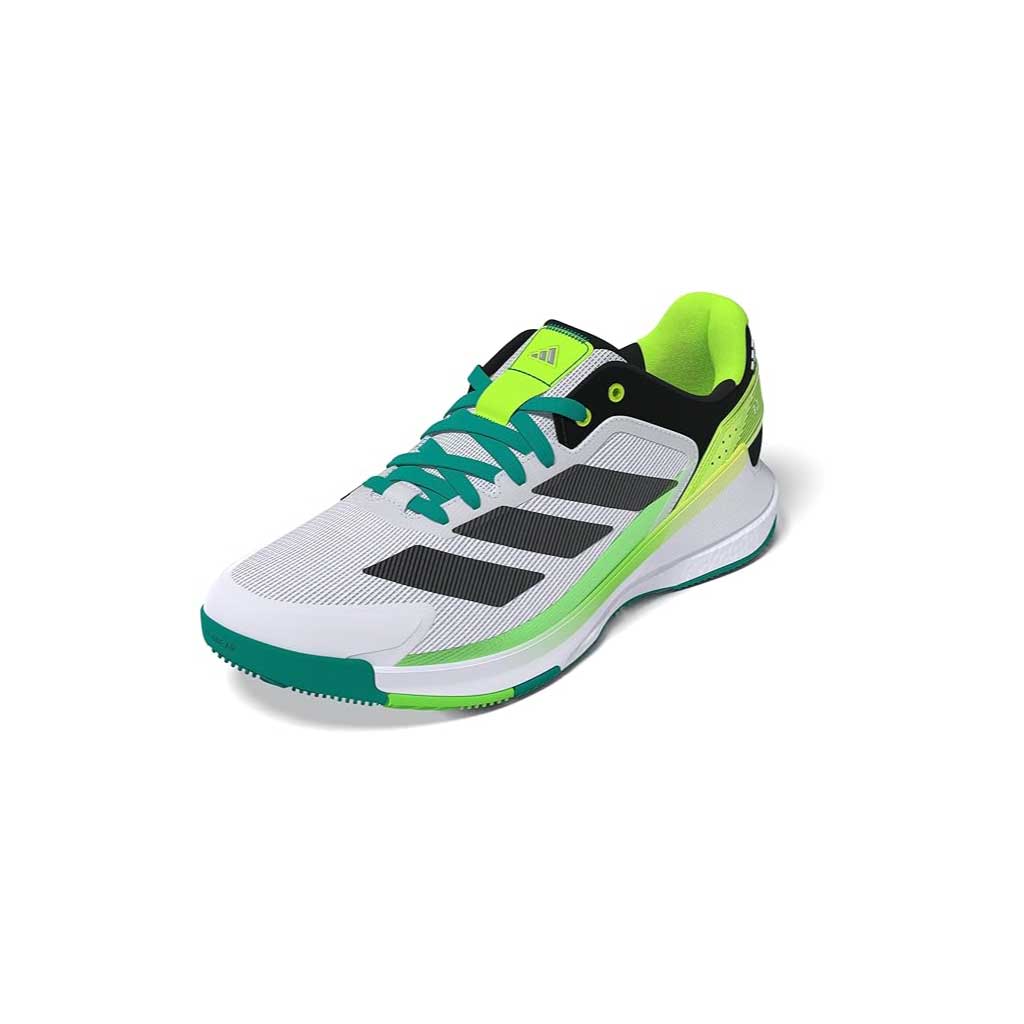
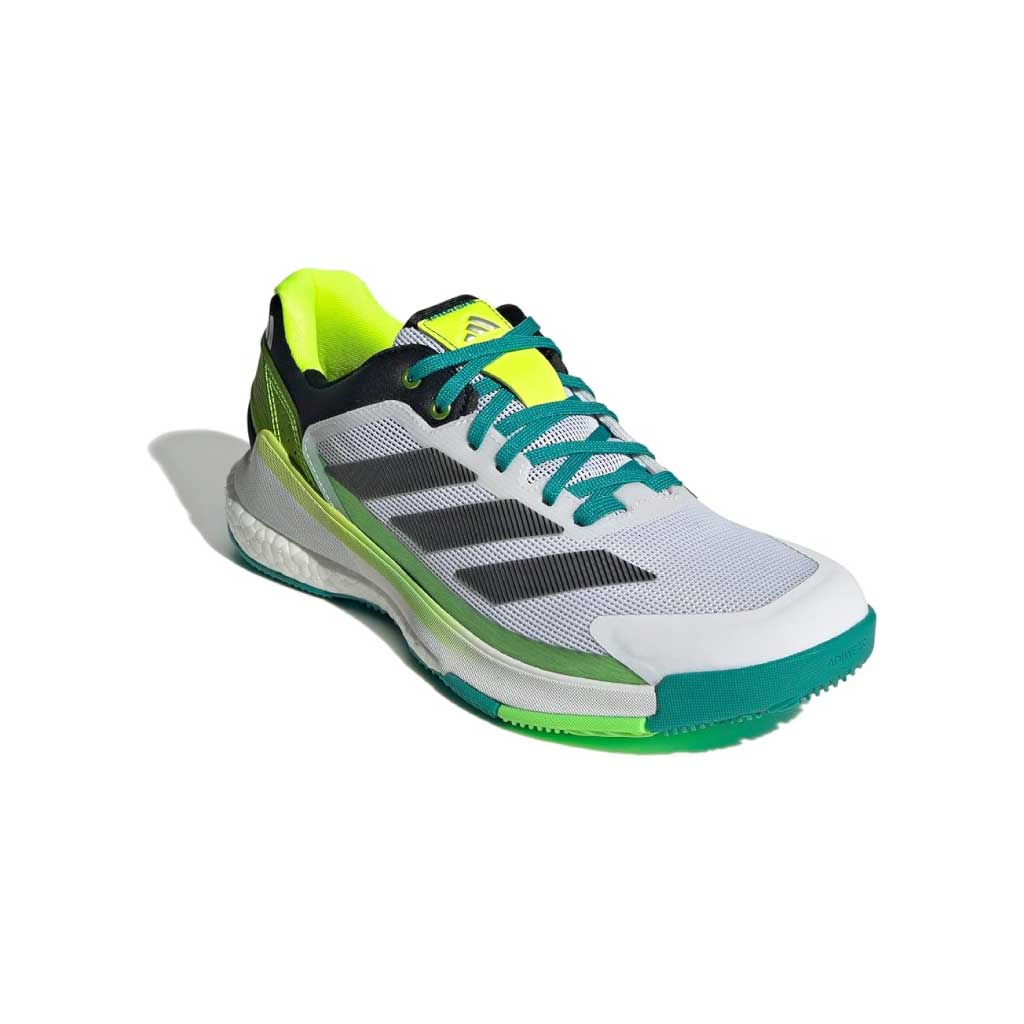
The Adidas Crazyquick Boost Padel Sneaker is designed for players who prioritize speed, cushioning, and a secure grip. It features Adidas Boost foam for energy return, a hybrid outsole for padel courts, and breathable mesh to keep your feet cool during intense rallies.
Designed with all-around padel players in mind, the Crazyquick Boost blends comfort and responsiveness. Its Boost midsole returns energy with each step, helping you stay quick on sudden cuts and pivots.
The hybrid outsole provides a secure grip on sand-filled turf while allowing for controlled slides, making it versatile across various court conditions.
A lightweight mesh upper enhances ventilation, while reinforced sides provide a secure fit. This balance of cushioning and stability makes it ideal for both attacking and defensive styles, reducing fatigue and joint strain over long matches.
Key Features
- Boost midsole for energy return
- Hybrid outsole for grip + mobility
- Breathable mesh upper with reinforced sides
Pros:
- Lightweight and responsive
- Strong joint-friendly cushioning
- Secure fit for side movements
Cons:
- Runs slightly narrow
- May wear faster for heavy sliders
Wilson Bela Pro Padel ShoesBest for: Stability & control
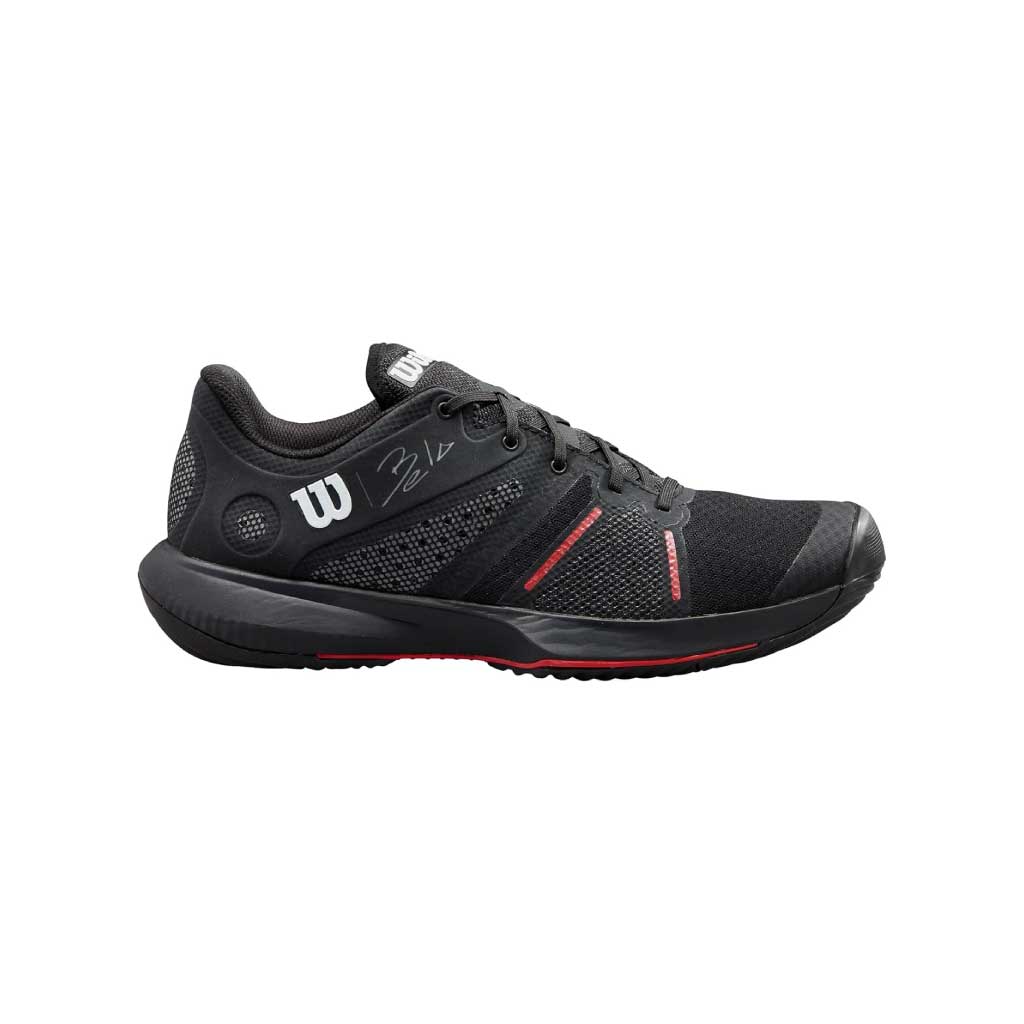
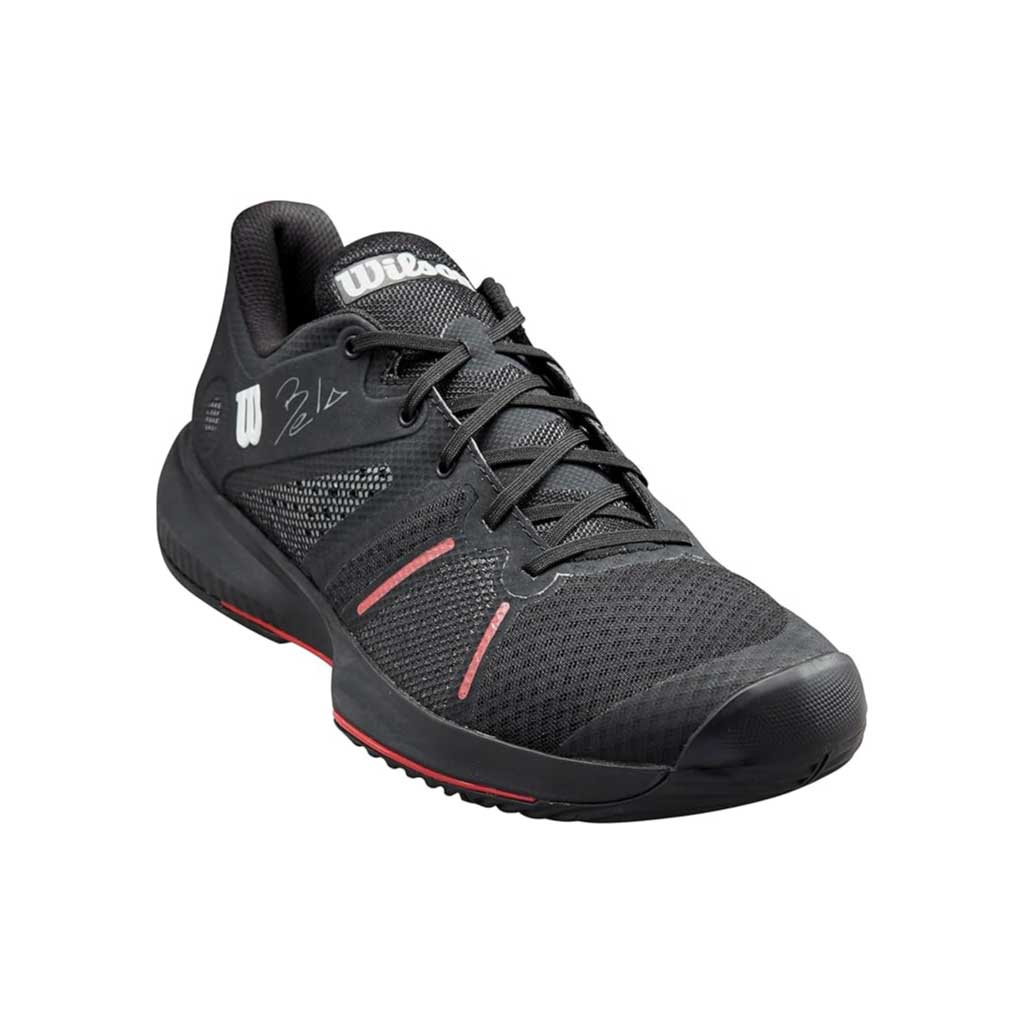
The Wilson Bela Pro Padel Shoes are engineered for stability and precision, making them ideal for aggressive players who frequently find themselves at the net. They feature a firm herringbone outsole, reinforced sidewalls, and responsive cushioning that supports sharp cuts and fast braking on sand-filled padel courts.
Built in collaboration with pro player Fernando Belasteguín (“Bela”), the Bela Pro is designed for those who demand maximum stability.
Its herringbone outsole bites into sandy turf, providing strong traction during explosive pushes. Reinforced lateral support reduces the risk of ankle roll, while the cushioned midsole ensures smooth landings.
A durable upper withstands drag and high-intensity play, making it suitable for competitive or tournament-level players.
If your game depends on quick net rushes, pivots, and controlled footwork, the Bela Pro is one of the most reliable performance shoes available in 2026.
Key Features
- Herringbone outsole for maximum traction
- Reinforced sidewalls for lateral stability
- Cushioned midsole for controlled landings
Pros:
- Excellent grip on sandy courts
- Strong ankle and lateral support
- Durable construction for high-level play
Cons:
- Heavier than lightweight models
- Higher price point
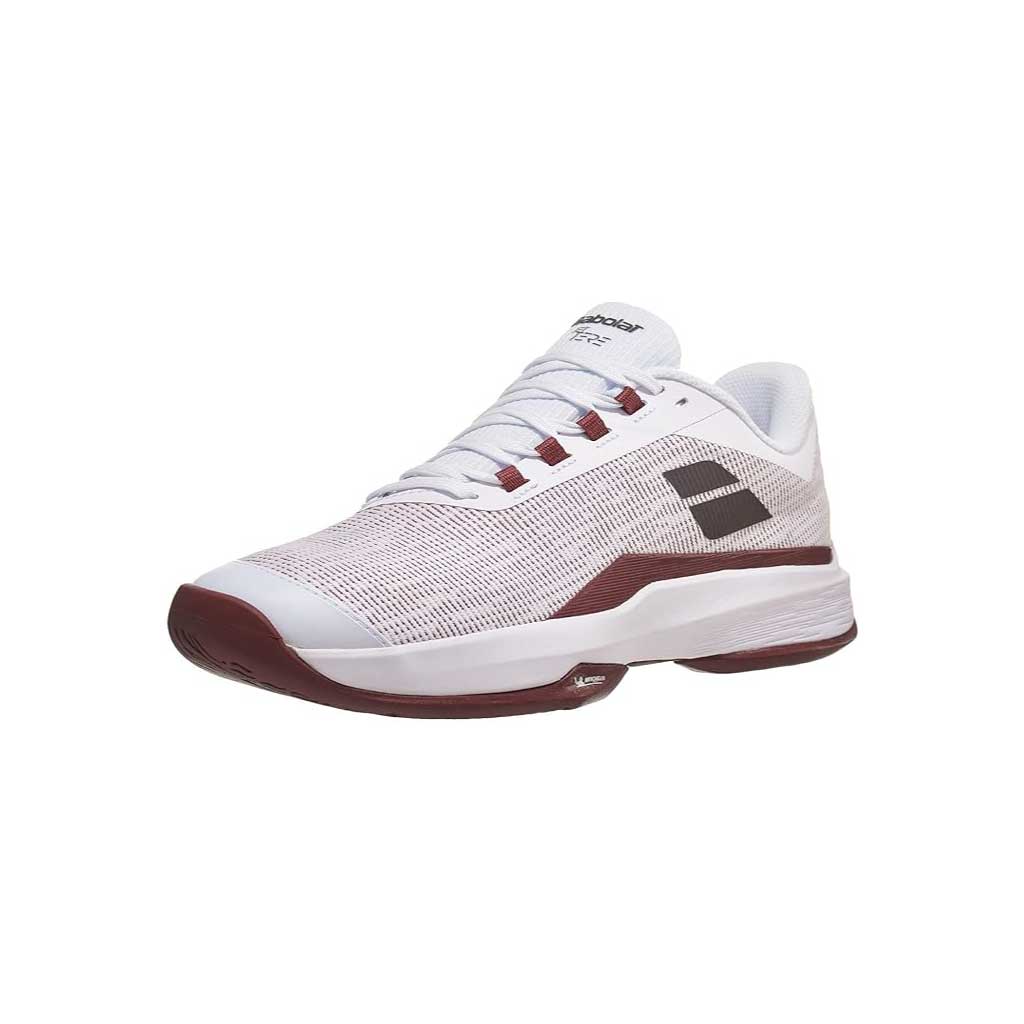
The Jet Tere 2 delivers a feather-light ride that feels quick from the very first session. The Jet Tere 2 features a breathable one-piece mesh upper, a Michelin outsole for enhanced durability, and a midsole that’s 5% thicker than the v1 for added comfort. It’s ideal if you value speed over bulk.
If you want to feel fast on court, this is the lightest-feeling Babolat model, around 320 g in EU 42.5. The one-piece mesh keeps air flowing, while integrated lateral reinforcements add structure without weighing you down.
Version 2 adds a 5% thicker midsole for softer landings, and the Michelin Premium rubber outsole boosts wear resistance on abrasive turf.
Testers praise its comfort and step-in feel, though some note it trades a bit of lateral support for that featherweight ride. Great for agile movers who don’t need a super-rigid chassis.
Key Features:
- Approx. 320 g in EU 42.5 for a light feel
- Michelin Premium rubber outsole for durability
- 5% thicker midsole vs v1 for added cushioning
Pros:
- You feel quick and agile from the start.
- Breathable and comfortable upper for extended sessions.
- Added cushioning improves impact protection vs v1.
Cons:
- Less lateral support than stiffer stability shoes.
- Flat laces/softer upper may not lock as firmly for aggressive cuts.
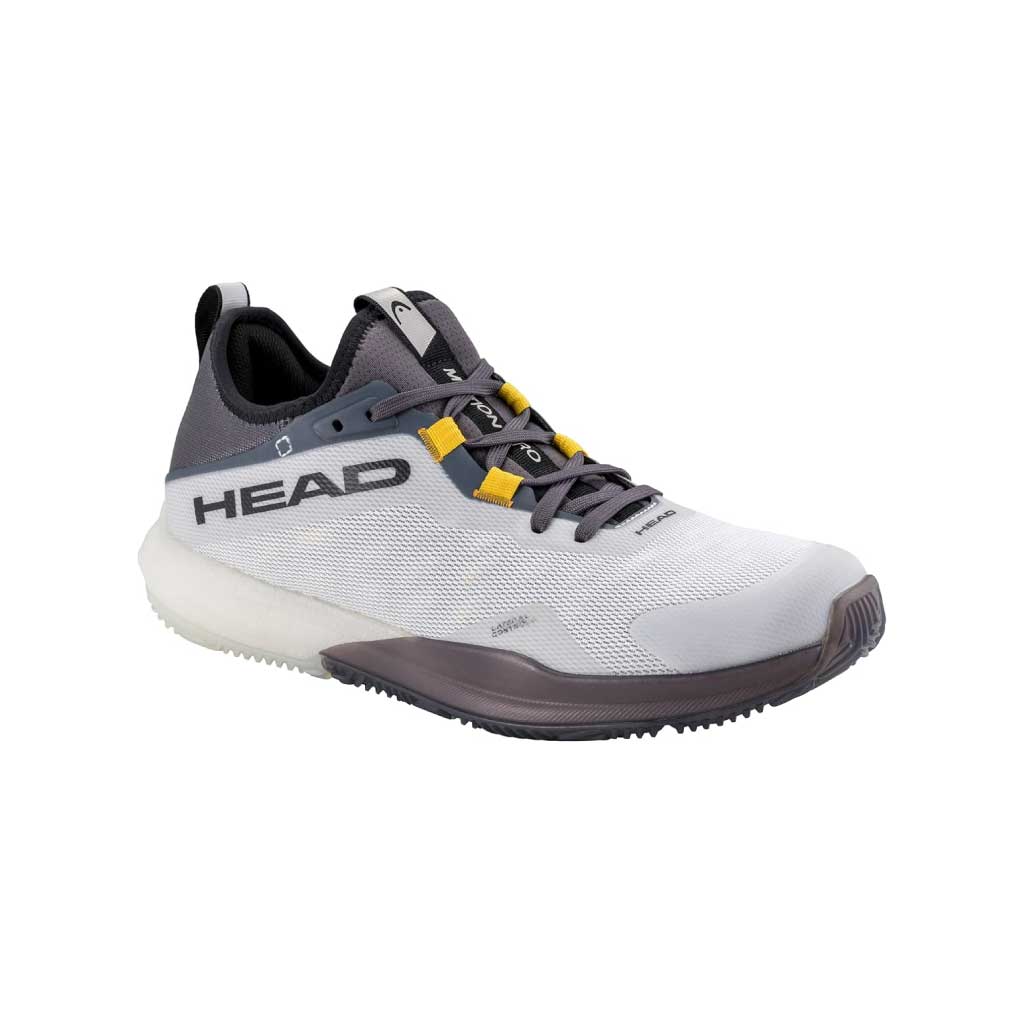
Head’s Motion Pro is a padel-specific shoe built for lateral stability and 360° movement. It combines a DynaFoam midsole with Lateral Control+ side support and a Hybrasion+ rubber outsole for bite on sand. A sock-fit upper and Cooling System ventilation keep feet secure and calm. Approx. 378 g in US 10.5.
Developed in collaboration with HEAD’s professional players, the Motion Pro is their first shoe explicitly engineered for padel, designed for multi-directional footwork.
Perforations in the outsole and midsole provide 360° airflow, while a sock-like construction upper offers step-in comfort and lockdown.
The DynaFoam EVA midsole feels responsive, and the Lateral Control+ with TPU supports helps prevent rollover on intricate lateral cuts.
The Hybrasion+ outsole uses a padel-specific tread for traction and wear resistance. Fit notes: true to size, medium width, low arch. Listed weight is ~378 g in US 10.5.
Key features:
- DynaFoam EVA midsole with responsive feel
- Lateral Control+ and TPU supports for side stability
- Hybrasion+ padel-specific outsole; Cooling System 360° ventilation; sock-fit upper
Pros:
- Excellent lateral stability for sharp cuts
- Breathable design with 360° ventilation
- Durable outsole compound for sandy turf
Cons:
- Heavier than lightweight “speed” models
- A firmer ride may feel stiff if you prefer plush cushioning
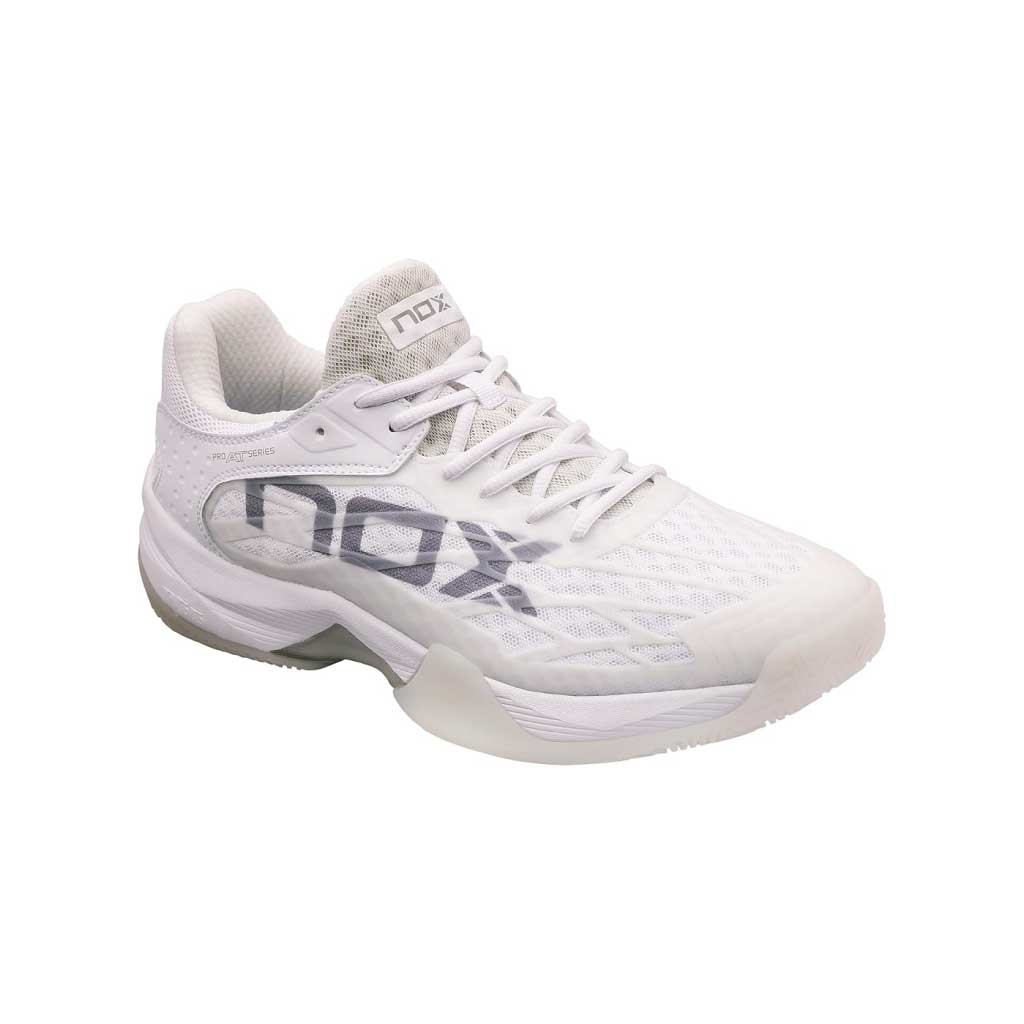
The Nox AT10 LUX is engineered to reduce injury risk while delivering comfort. It features a sock-collar fit, AGG (Advanced Gravity Geometry) drop for improved posture, a Strobel-mounted popcorn EVA rubber sole with a low-density phylon midsole for cushioning, and a herringbone and small stud outsole for enhanced grip. In US size 10, it weighs about 411 g.
If you want both protection and high performance, the AT10 LUX combines several technologies to help. The AGG drop raises the heel-to-toe height slightly, easing pressure on the calves and making standing drills less tiring.
A Strobel-mounted EVA and phylon midsole enhance energy return, helping to prevent long rallies from wearing you down. The upper features an elastic sock-collar and Airmesh with polymer reinforcement for a snug fit and optimal airflow.
The outsole design combines herringbone grooves with tiny studs to strike a balance between grip and slide, while inner lateral reinforcements (AbraXone) help resist abrasion. Feel: true to size, medium width.
Key Features:
- AGG (Advanced Gravity Geometry) technology for better heel-to-toe drop, reduces calf strain
- Strobel-mounted popcorn EVA rubber sole + low-density injected phylon midsole for cushioning and energy return
- Herringbone pattern with small studs outsole + inner lateral reinforcement (AbraXone) for grip and durability
Pros:
- Excellent fit thanks to sock collar design; stays snug during lateral movement
- Premium cushioning gives comfort in long sessions without feeling bulky
- Hybrid grip performs well on both high-sand and low-sand courts; good abrasion resistance
Cons:
- Heavier than some “speed-first” shoes (≈ 411 g in US 10) may slow down quick sprints.
- High price; certain users report outsole wear after heavy use on very abrasive courts.
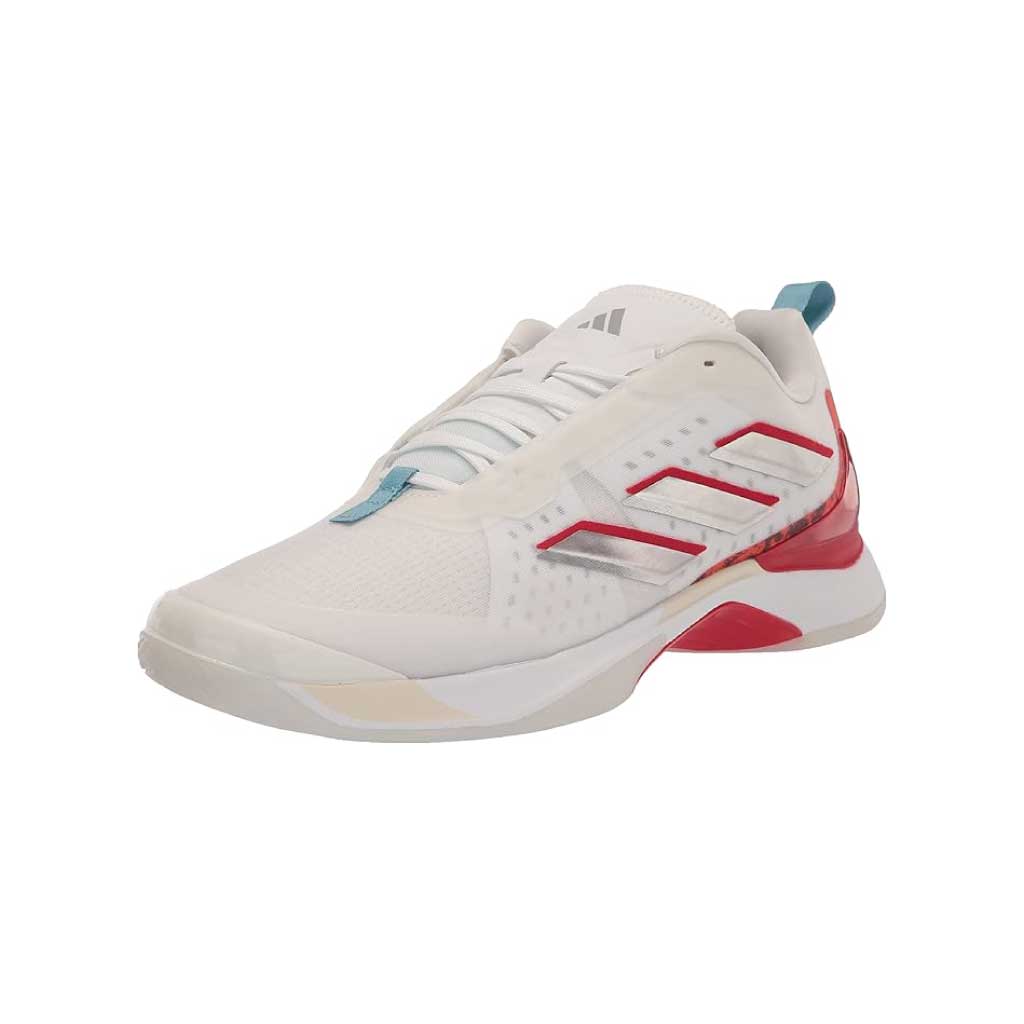
The Avacourt is a women-specific shoe built with Bounce Pro cushioning, a Torsion System for stability, and an Adiwear herringbone outsole for dependable grip on court. The breathable mesh upper keeps you good, and the weight comes in at around 11.7 oz (US 8.5) for an easy, fast feel.
If you want comfort without losing support, Avacourt hits a sweet spot. The Bounce Pro midsole feels cushioned yet responsive, while the Torsion System provides midfoot control for confident side-to-side movements.
A women-specific last improves fit, and the Adiwear herringbone tread provides traction and durability. The mesh upper boosts airflow for long sessions.
Although it’s a tennis model, the herringbone outsole also works on sand-filled padel courts, especially lower-sand venues; if you mainly play heavy-sand surfaces, consider a padel-specific sole. Approx. 11.7 oz (US 8.5).
Key Features:
- Bounce Pro midsole for responsive cushioning.
- Torsion System for midfoot stability.
- Adiwear herringbone outsole; non-marking rubber.
Pros:
- Comfortable, women-specific fit with breathable mesh.
- Stable on lateral moves thanks to the Torsion System.
- Durable Adiwear tread with dependable grip.
Cons:
- Not a padel-dedicated sole; heavy-sand courts may favor padel-specific tread.
- Weight can feel modestly higher than ultra-light “speed” shoes in this class.
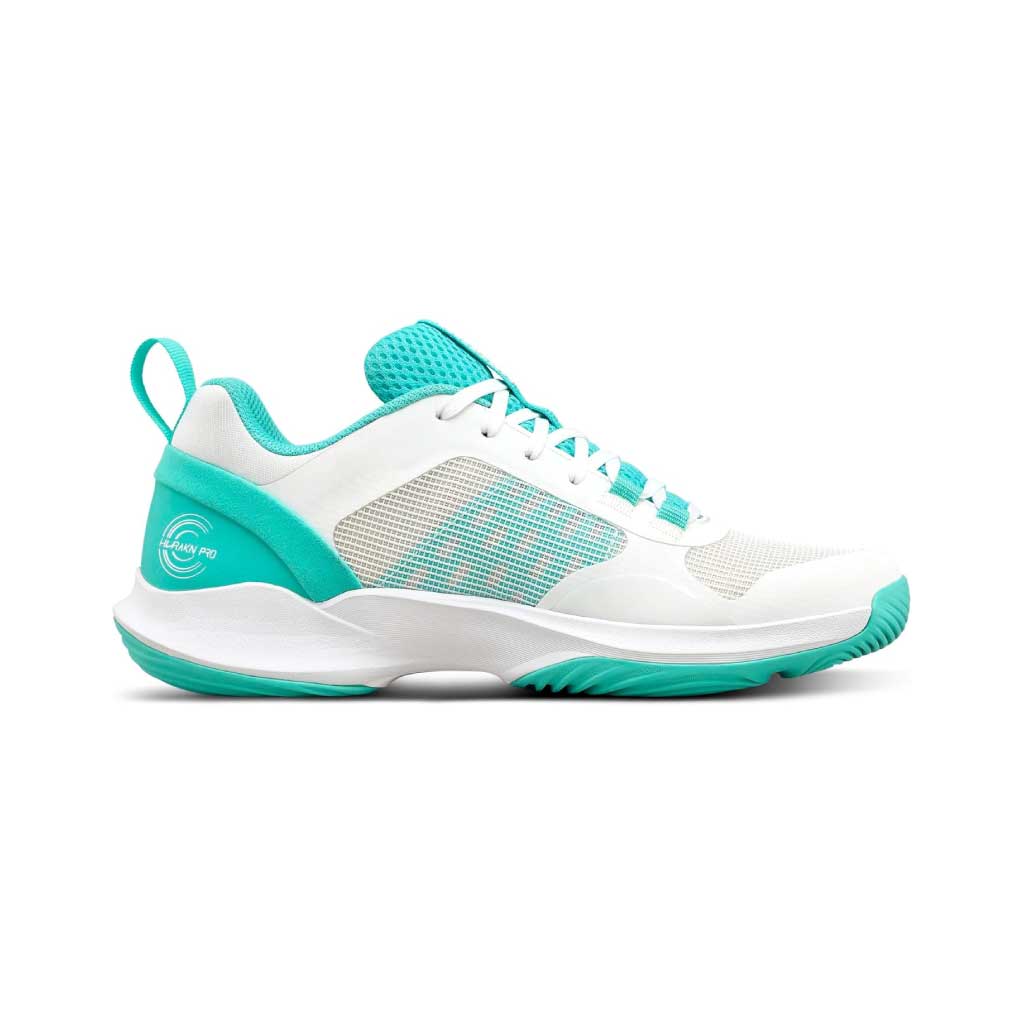
The Hurakn Pro V2 features a women-specific build with a padel outsole designed for rotational mobility and an asymmetrical TPU heel counter that strengthens stability and arch support. Cushioning is responsive, and the upper is made from lightweight, breathable materials. It’s a strong pick if you want extra ankle confidence on sandy courts.
This model is tuned for the way you move in padel. The padel-specific tread favors clean pivots and quick direction changes, while the elongated medial TPU heel counter increases rearfoot control to limit rollover.
A women ‘s-specific heel and arch improve lockdown without pressure. The midsole provides lively cushioning for repeated starts and stops, and the upper blends mesh with recycled TPU for breathable, supportive containment.
If you’ve struggled with ankle wobbles or inconsistent traction on sand-filled turf, this setup helps you plant, brake, and turn with more control.
Key Features:
- Padel-specific outsole engineered for rotational mobility on sandy turf.
- Asymmetrical, elongated medial TPU heel counter for added stability and arch support.
- Breathable mesh + recycled TPU upper for light, secure containment.
Pros:
- Excellent lateral and rearfoot stability for quick cuts.
- The outsole geometry supports smooth pivots and rapid direction changes.
- Breathable, lightweight construction keeps feet cooler during extended play.
Cons:
- A firmer, performance-oriented feel versus ultra-plush cushioning shoes. (inferred from stability-focused design)
- Premium pricing compared with budget models.
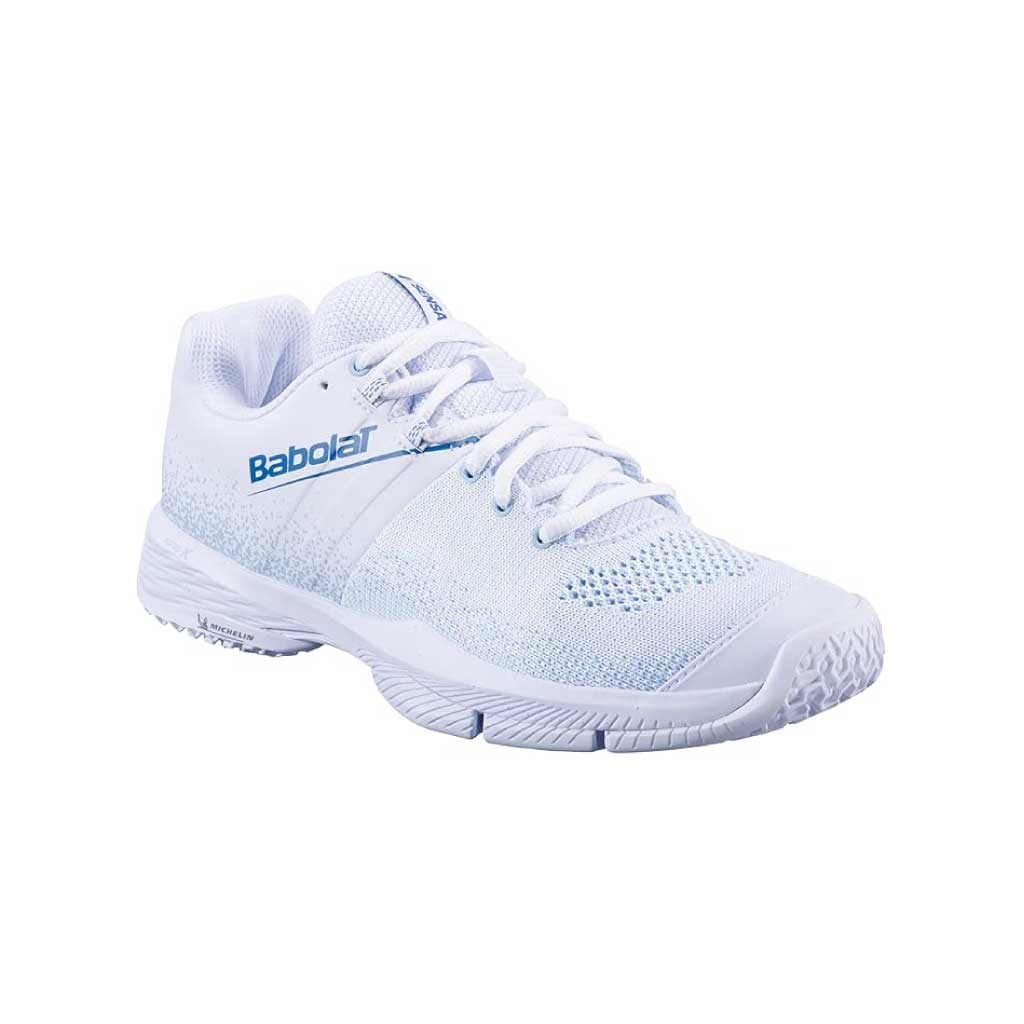
The Sensa offers firm support while maintaining comfort. Dual Power Straps stabilize lateral moves, KPRS-X cushioning protects heels on landings, and a Michelin rubber outsole (padel pattern) delivers traction on sand-filled turf. A breathable mesh/Matryx forefoot keeps feet cool. Listed weight is about 280 g (EU 38).
If you want a women-specific shoe that feels secure on every cut, the Sensa focuses on stability and comfort. The integrated Power Straps lock the midfoot for confident side steps, while KPRS-X heel cushioning absorbs repetitive impact during quick stops.
A ventilated mesh/MatryxSL forefoot helps with heat, and the Michelin outsole uses a padel tread (S-shaped/hybrid) to balance bite and smooth pivots on different sand levels.
The upper is reinforced in high-wear zones for longevity. It’s a straightforward recommendation if you’ve experienced ankle wobbles or heel soreness.
Key Features:
- Power Straps for added midfoot/lateral support.
- KPRS-X heel cushioning with EVA insert.
- Michelin padel outsole (S-pattern/hybrid) for grip and durability.
Pros:
- Stable feel on aggressive side cuts.
- Heel comfort that holds up during long sessions.
- Traction tuned for padel courts with a durable compound.
Cons:
- Not the lightest option in the category (≈ 280 g EU 38).
- Forefoot feels structured; flexible-fit seekers may prefer softer uppers. (inferred from stability focus)
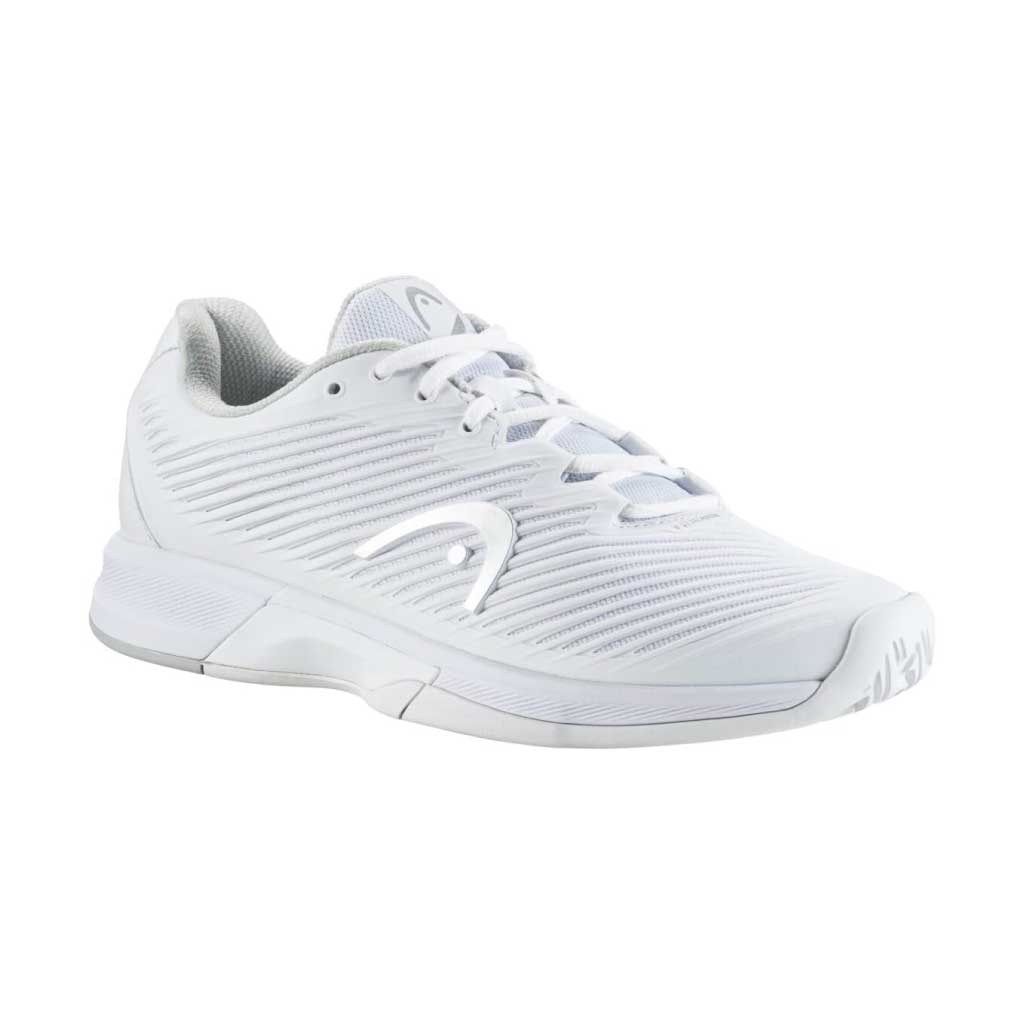
The Head Revolt Pro Women’s Sneaker is built for players who need durability and comfort on demanding courts. It combines a TRI-N-RG midsole for shock absorption, Hybrasion+ outsole for wear resistance, and Drift Defense protection at the toe and medial side. The weight is approximately 360 g (EU 38.5).
This shoe is designed for players who grind on abrasive surfaces and require a reliable build. The TRI–N-RG system disperses impact, supports heel stability, and returns energy through the midfoot.
A Hybrasion+ rubber outsole provides strong traction and extended durability, while Drift Defense reinforcements in the toe and medial side add protection during slides and drags.
The upper is a combination of mesh and PU layers, providing both breathability and structure. At ~360 g in women’s EU 38.5, it’s slightly heavier but makes up for it with long-lasting performance.
Key Features:
- TRI-N-RG technology for cushioning, stability, and energy return.
- Hybrasion+ outsole for durability on abrasive turf.
- Drift Defense toe/medial reinforcement against wear.
Pros:
- Very durable outsole and toe protection.
- Balanced cushioning and support for extended play.
- Good airflow with mesh/PU upper mix. (inferred from construction)
Cons:
- Heavier than speed-oriented models (~360 g EU 38.5).
- Firmer feel; less “plush” than softer cushioned shoes. (inferred from stability focus)
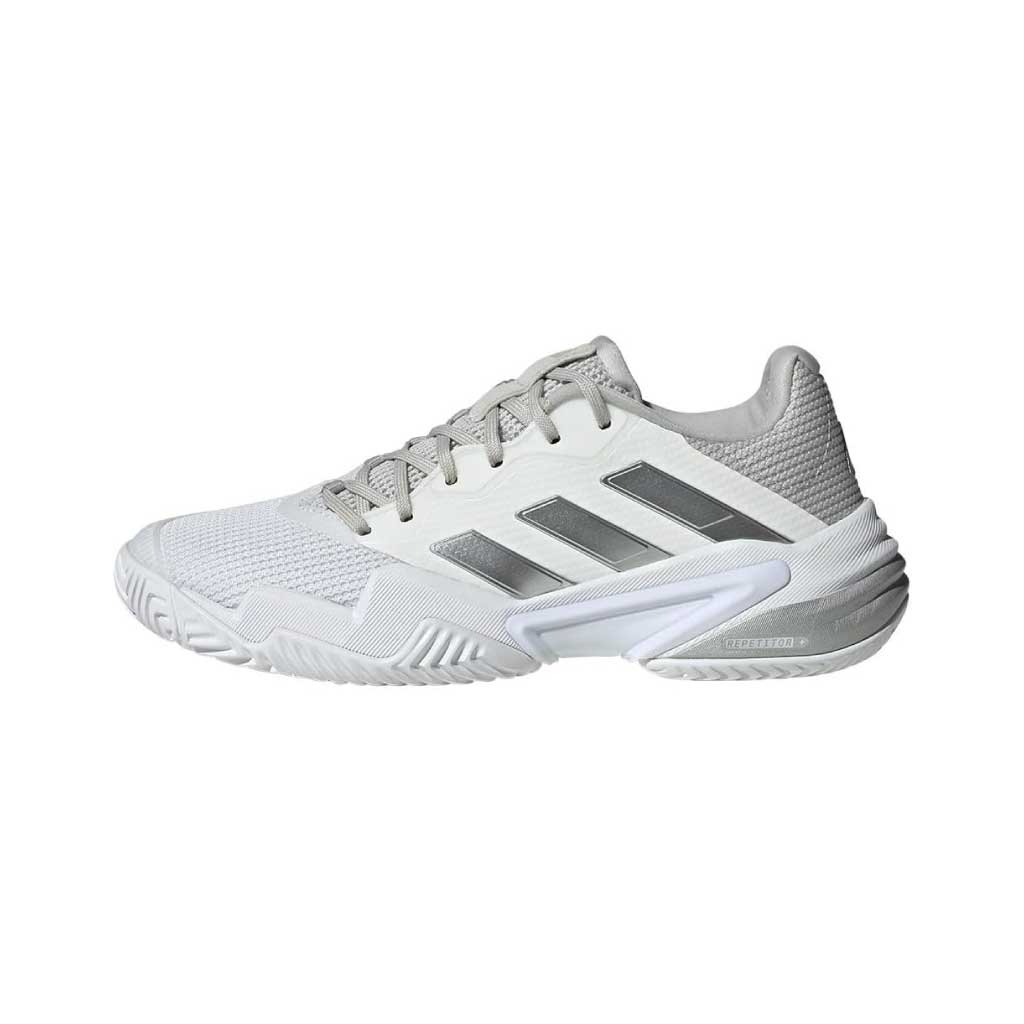
The Barricade 13 is a stability-focused shoe featuring a REPETITOR midsole, Torsion System for midfoot control, Geofit Sensepods for heel lockdown, and a durable Adiwear split-herringbone outsole. The weight sits around 12–13 oz in US sizes 8–8.5, delivering firm support for hard plants and quick direction changes.
If your game needs a secure footing and precise stops, the Barricade 13 is built to keep you in control. The REPETITOR foam balances cushioning with a firmer ride, while the Torsion System resists unwanted twist on lateral cuts.
Geofit Sensepods fill the heel for confident lockdown, and the Adiwear 2.0 split-herringbone tread grips and slides predictably on abrasive courts.
Playtest data consistently score it high for stability and durability, with some users noting a short break-in around the ankle collar. Listed weights clock near 12–12.9 oz in women’s US 8–8.5.
Key features:
- REPETITOR midsole + Torsion System for stable, controlled movement.
- Geofit Sensepods feature heel fit and asymmetric lacing to lock the midfoot.
- Adiwear 2.0 features a split-herringbone outsole for enhanced traction and wear resistance.
Pros:
- Class-leading stability and outsole durability for frequent play.
- Confident heel lockdown from Geofit; secure midfoot hold.
- Predictable grip/slide on sanded or abrasive courts via split-herringbone.
Cons:
- Break-in can feel stiff around the ankle for some players.
- Heavier feel than speed-oriented shoes (≈ 12–12.9 oz, W US 8–8.5).
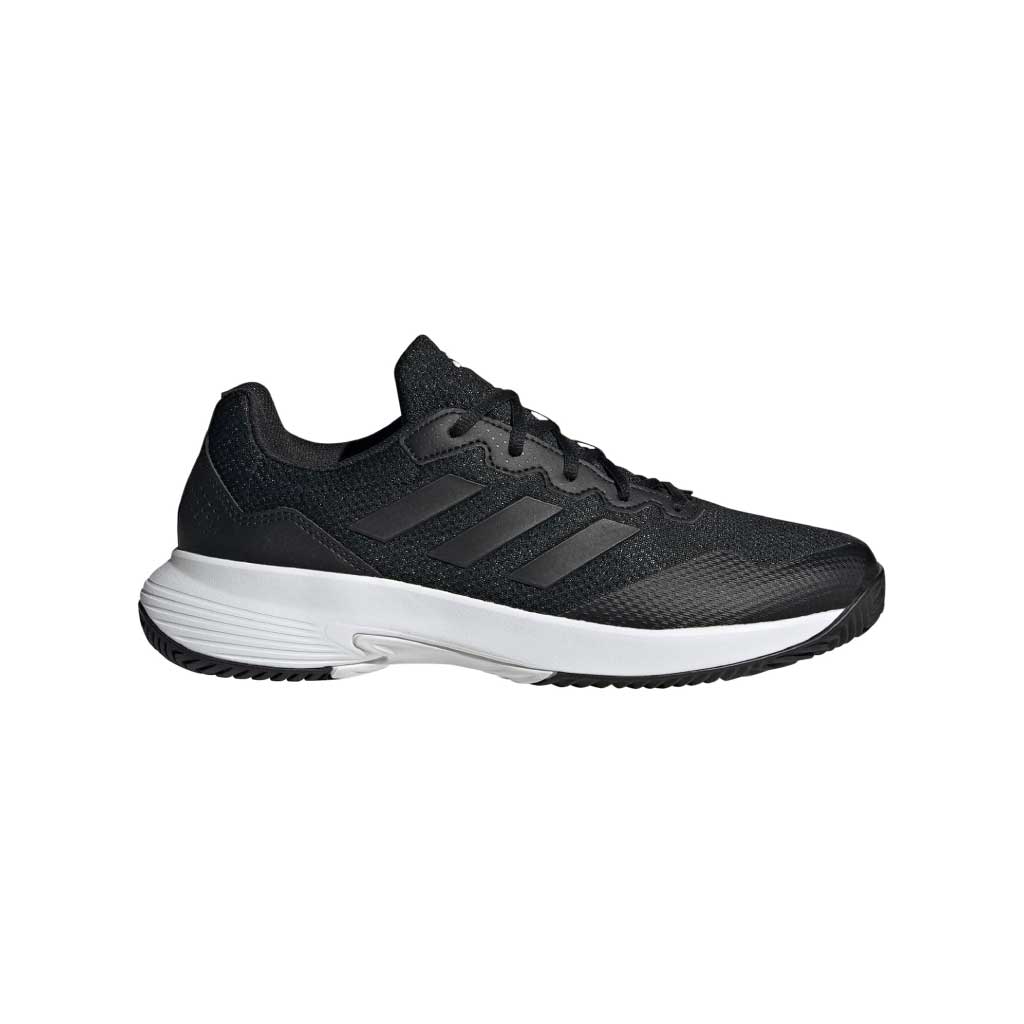
The Gamecourt 2 delivers budget-friendly performance with a full EVA midsole for comfort, an Adiwear herringbone outsole for traction, and an open mesh upper for breathability. It’s light for its class (around 11.9 oz / 336 g in men’s US 9) and ideal for new or casual players.
Gamecourt 2 focuses on the basics you need to stop slipping without overspending. The full-length EVA midsole gives soft landings, while the Adiwear hard-court tread with a herringbone profile bites well and wears slowly.
A padded heel and open mesh upper add comfort and airflow during long sessions. Independent lab tests indicate a weight of approximately 11.9 oz in men’s US 9, which feels quick for an entry shoe.
Fit notes from retailers mention it can run a touch long; consider sizing guidance if you’re between sizes
.Key Features:
- Full EVA midsole for underfoot comfort.
- Adiwear herringbone outsole for traction and durability.
- Open mesh upper with padded heel collar.
Pros:
- Reliable grip and cushioning for first-time padel players.
- Lighter than many budget models (≈ 11.9 oz, M US 9).
- Breathable and comfortable straight out of the box.
Cons:
- Not padel-specific; the outsole is tuned for hard courts (still works on low- to medium-sand courts).
- Fit can run slightly long for some feet.
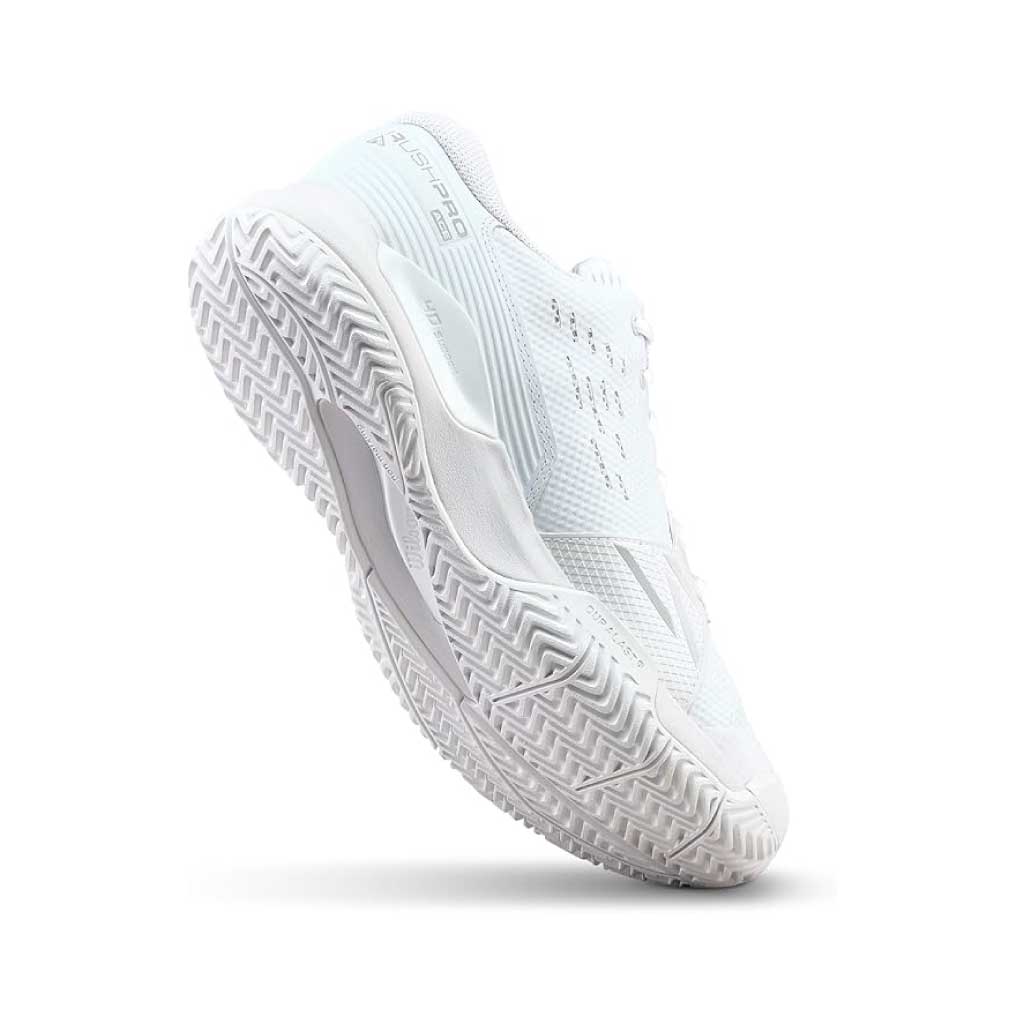
If you need a wider fit without losing support, Rush Pro Ace is a substantial value. A roomy last, R-DST+ cushioning, and DF2 9 mm drop keep landings comfortable, while a Duralast rubber outsole adds traction and durability. Approx. 11.9 oz (US 9); 12.5 oz (US 10.5).
This model is known for its generous fit and easy step-in feel, making it a good match for those who find standard shoes too tight.
The Sensifeel mesh upper strikes a balance between breathability and support, while R-DST+ foam softens impact and returns energy during sprints.
A DF2 9 mm heel-to-toe drop offers a comfortable ride for extended sessions, and the Duralast outsole provides abrasion resistance and a reliable grip across various club surfaces.
Reported weights are approximately 11.9 oz in US 9 and 12.5 oz in US 10.5, maintaining competitiveness in the budget category.
Key Features:
- Wide and comfortable fit for more forefoot room.
- R-DST+ midsole cushioning; DF2 ~9 mm drop.
- Duralast high-density rubber outsole for traction and wear.
Pros:
- Roomy fit reduces squeeze for broader feet.
- Cushioning and the 9 mm drop feel balanced over extended play.
- The durable outsole provides excellent grip on common club surfaces.
Cons:
- The support chassis feels less locked-in than the top Rush Pro models.
- Not a padel-specific tread; best on low/medium-sand or hard courts.
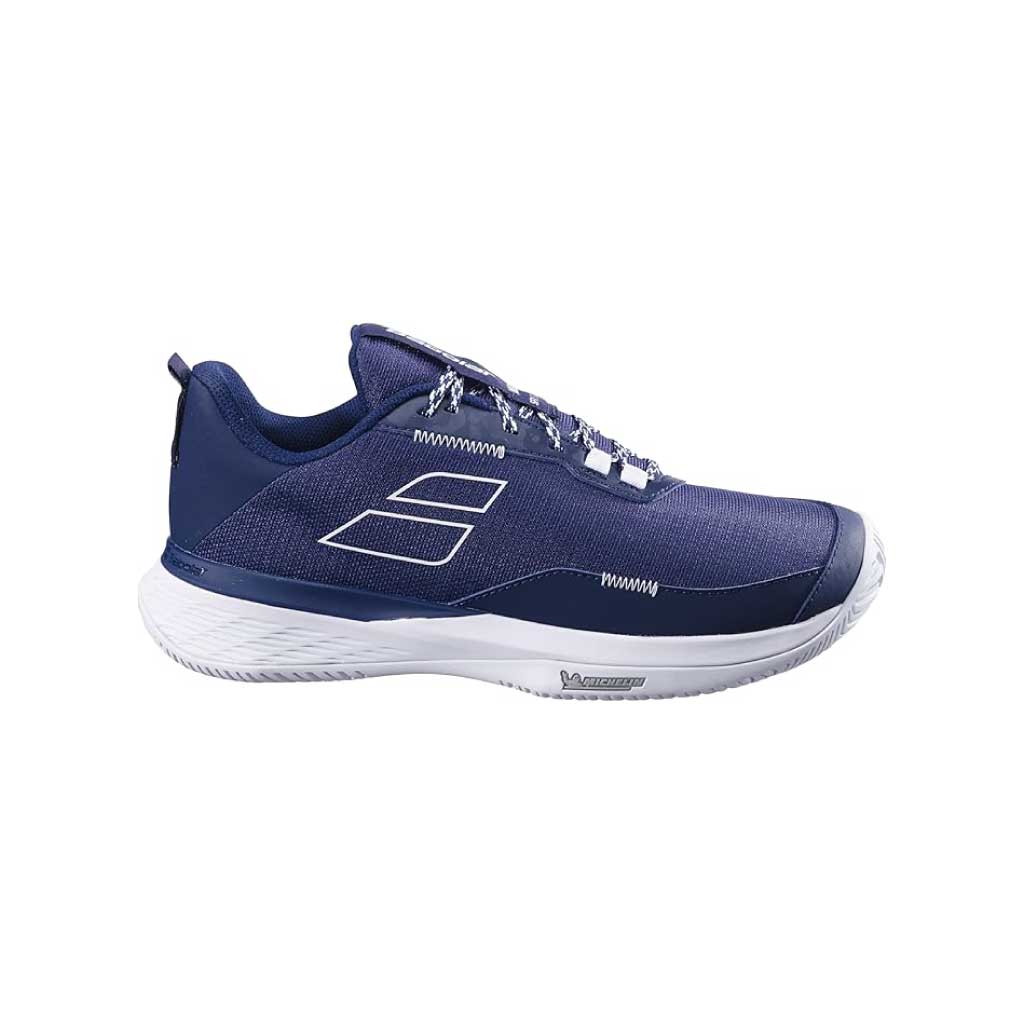
If you want room for your toes and soft step-in comfort, this is a smart budget pick. SFX Evo features a 6% wider last, a soft Ortholite insole, breathable mesh upper, and a durable Michelin rubber outsole that provides excellent grip on club courts.
The SFX Evo prioritizes comfort at an affordable price point. The 6% wider forefoot provides extra space for those who find standard shoes too tight, while the Ortholite insole supports your foot during extended sessions.
The lightweight mesh upper keeps air flowing, and the Michelin rubber outsole delivers dependable traction and wear on typical club surfaces (low to medium sand or hard courts).
If you struggle with hot feet, pinched toes, or fatigue from firm shoes, SFX Evo addresses these issues with a roomy fit and a cushioned ride.
Key Features:
- 6% wider last for extra forefoot room.
- Ortholite® insole for soft, supportive cushioning.
- Michelin rubber outsole for grip and durability.
Pros:
- Provides a comfortable fit for wide or comfort-seeking feet.
- Breathable mesh helps keep feet cooler.
- Durable outsole compound for frequent play.
Cons:
- Not a padel-specific tread; best on low/medium-sand or hard courts.
- Softer upper locks less firmly than stiff stability models. (inferred from comfort-first build)
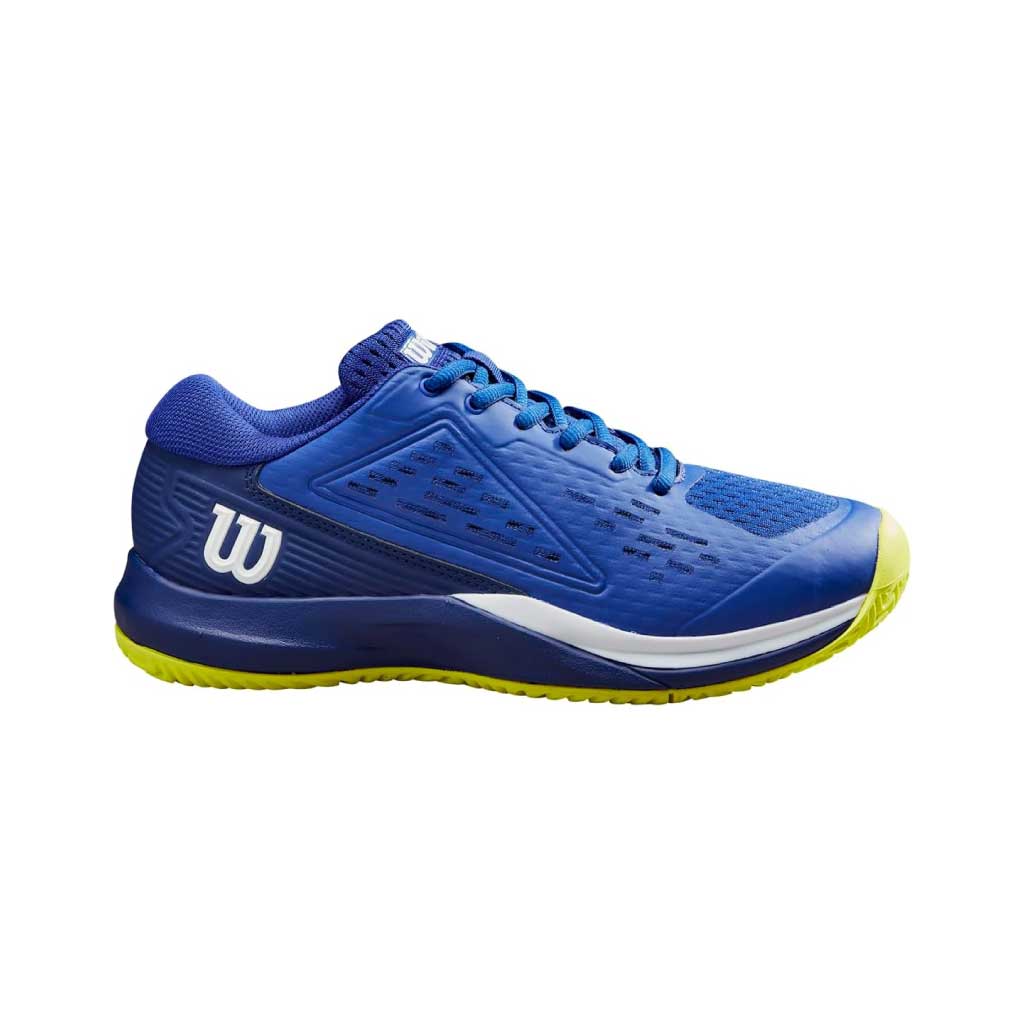
If your junior needs more room and reliable traction, Rush Pro Ace Junior is a great match. It accommodates wider feet, features a breathable mesh with a cushioned instep, and is equipped with a Duralast rubber outsole. Listed weight is about 9.9 oz.
The Rush Pro Ace Junior provides an easy-to-wear fit with sturdy construction for active play. The fit accommodates wider feet, allowing toes to splay naturally.
The mesh upper breathes, while the cushioned sockliner/instep improves step-in feel for drills and matches. Underfoot, Duralast rubber targets abrasion resistance and a steady grip on all-court club surfaces.
The reported weight is approximately 9.9 oz, making the shoe easy to manoeuvre for younger players learning quick stops and starts. If your child complains about tight shoes or slippery traction, this model addresses both.
Key Features:
- Accommodates wider feet for comfort and toe room.
- Breathable mesh with cushioned instep/sockliner.
- Duralast rubber outsole for grip and durability.
Pros:
- Easy, comfortable fit for growing feet.
- Traction suitable for typical junior club courts.
- Light enough for quick movement (≈ 9.9 oz).
Cons:
- Not a padel-specific tread; best on all-court/low-sand surfaces.
- Cushioning/lockdown is gentler than top-tier performance models. (inferred for junior comfort focus)
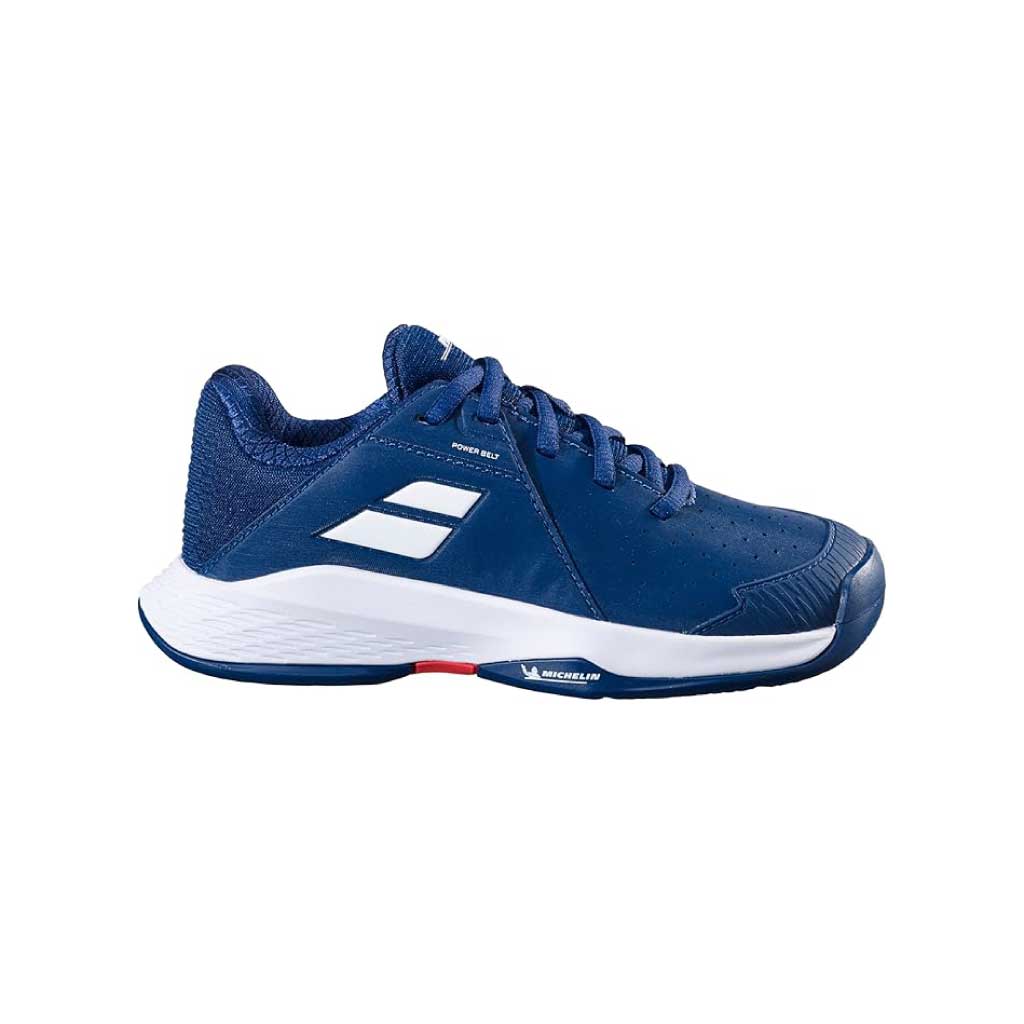
For kids who move their feet laterally, Propulse Junior 3 features midfoot strap support, a forefoot guard for drag zones, and a Michelin outsole for durable traction. It’s a strong choice if your junior needs more stability and a more rigid sole for frequent play.
This redesign focuses on control and wear life. The midfoot strap provides powerful lockdown, ensuring feet stay centered during side steps.
A reinforced forefoot guard protects the upper against toe drags, and the Michelin rubber outsole supplies grip and abrasion resistance on all-court club surfaces.
If your child is slipping on turns or burning through outsoles, this model answers both with extra support and a tough compound. It’s ideal for weekly coaching and matches on mixed indoor/outdoor courts.
Key Features:
- Midfoot support strap for secure lockdown.
- Forefoot guard for upper protection.
- Michelin outsole for grip and durability.
Pros:
- Better side-to-side stability for active juniors.
- Upper lasts longer thanks to the forefoot guard.
- Durable outsole stands up to frequent play.
Cons:
- More structured feel than very soft, flexible junior shoes. (inferred from support strap & guard)
- All-court tread, not padel-specific; best on low-sand or hard courts. (inferred from product positioning)
How We Test and Score Shoes (Our Review Framework)
Eascart reviews padel shoes using a consistent framework built on traction, stability, cushioning, fit, breathability, durability, and value. The process blends independent test data, verified player feedback, and brand specifications. Every shoe is scored against the same criteria, ensuring fair and easy-to-understand comparisons.
Criteria and weights
The scoring system covers seven areas with set weights:
- Traction (20%): Grip and braking on sand-filled turf and indoor club courts.
- Lateral stability (20%): Sidewall strength, heel hold, and torsion control during cuts.
- Cushioning (15%): Shock absorption and responsiveness during stops and push-offs.
- Fit and width (15%): Heel lockdown, toe room, and comfort across different foot shapes.
- Breathability (10%): Heat and sweat management during extended matches.
- Durability (10%): Outsole wear and upper resistance to abrasion.
- Value (10%): Balance between performance, price, and expected lifespan.
Review protocol
Each shoe is assessed on sand-filled artificial grass courts and common indoor club surfaces. Review sessions include structured footwork drills such as lateral shuffles, sharp pivots, and split-step sprints. Notes cover braking distance, slide control, and comfort under repetitive play. Independent reports and brand data are cross-checked to verify durability, outsole hardness, and cushioning performance.
Score interpretation
Scores translate into clear choices:
- 4.5–5.0: Excellent grip, cushioning, and fit across conditions.
- 4.0–4.4: Strong performance with minor trade-offs.
- 3.5–3.9: Reliable entry or practice option.
- Below 3.5: Limited performance; best only for specific needs such as price or unique fit.
Fit and sizing notes
Fit is reviewed in true-to-size and half-size variations when available. Key areas include heel slip, toe-box space, and arch support. Brands with narrow or wide tendencies are highlighted, enabling players to make faster, more accurate sizing decisions.
Update policy
Eascart refreshes shoe reviews when models change. If midsoles, outsoles, or uppers receive significant updates, the shoe is reassessed. Each review includes an “updated on” date, allowing readers to know when the information reflects the current design.
Which Padel Shoes Fit Your Level of Play?
Not every padel shoe fits all players. Beginners often need comfort and grip, regular players look for durability with balanced performance, and competitive athletes demand maximum stability and structure. Matching your footwear to your skill level improves safety, control, and overall results on court.
What Are the Best Padel Shoes for Beginners and Casual Players?
Beginners and casual players benefit from padel shoes that focus on grip, comfort, and value. Entry models protect your feet and reduce the risk of slips on sand-filled courts. A softer fit also lowers the chance of blisters. These features make learning easier and build confidence as your skills grow.
Starting padel requires shoes that keep you steady and comfortable. Full EVA midsoles give soft landings, while herringbone soles add dependable traction on sand-filled turf. Most beginner shoes in 2024–25 weigh between 320 and 350 g for men and between 285 and 320 g for women.
This balance helps you move quickly without extra bulk. Mesh uppers add airflow and keep feet cooler during long matches. Past-season models cost less but deliver the same level of safety. At this stage, comfort and basic stability matter more than advanced technology.
Key Priorities for Beginners and Casual Players
- Reliable traction: Herringbone or hybrid soles reduce slips on sand-filled courts.
- Soft cushioning: EVA foams protect joints during long sessions.
- Comfort-focused uppers: Mesh and padding prevent hotspots.
- Budget value: Last-season shoes offer significant savings with similar features.
- Forgiving fit: A roomy toe box lowers blister risk and adds comfort.
When you’re ready, check our full guide: Best Padel Shoes for Beginners.
Which Are the Best Padel Shoes for Regular Players?
Regular players require padel shoes that strike a balance between durability and performance. You play more often, so your shoes must last longer and provide a better grip. Cushioning should handle repeated impacts, while reinforced soles and uppers resist wear and tear. This balance keeps you moving with control and comfort.
As a regular player, your sessions are longer and more intense. Shoes in this range weigh approximately 330–360 g for men and 290–330 g for women, striking a balance between speed and stability. Reinforced outsoles with herringbone or hybrid patterns extend traction life on sand-filled turf.
Uppers often include extra overlays to prevent early wear around the toe box. Cushioning systems, such as EVA or GEL, handle repetitive jumps and stops without flattening quickly. The right balance means fewer replacements and consistent performance every time you step on court.
Balance Durability and Performance
- Firmer outsoles: Reinforced rubber compounds reduce tread wear.
- Reliable traction: Hybrid or herringbone soles maintain a steady grip over months of play.
- Cushioning upgrades: Midsoles with EVA blends or GEL™ protect joints from stress.
- Durable uppers: Added overlays to prevent damage from slides and drags.
- Weight balance: Models are designed to be light enough for speed while remaining solid for stability.
What Are the Best Padel Shoes for Competitive and Pro Players?
Competitive players demand padel shoes that deliver maximum stability and precision. At higher speeds, control matters more than comfort alone. Advanced shoes lock the heel, secure the midfoot, and use firm chassis designs. This support helps you plant harder, cut sharper, and protect joints during aggressive play.
As matches become faster, the margin for error decreases. The best padel shoes for competitive and pro players weigh around 340–370 g for men and 300–340 g for women, providing structure without feeling too heavy. Reinforced TPU sidewalls and stiff midsoles give stability to the foot during explosive cuts. Heel counters hold you firmly in place, reducing the risk of rolling. Premium cushioning foams, such as GEL or Boost, absorb impact without flattening quickly. Durable outsoles with hybrid tread patterns also extend grip life on sand-filled courts under heavy play.
Maximum Stability and Structure
- Firm chassis: TPU frames limit twisting and keep the foot aligned.
- Locked heel: Stiff heel counters stop unwanted movement.
- Stable traction: Hybrid patterns provide reliable traction for sudden stops and fast pivots.
- Protective cushioning: Premium foams absorb impact while staying responsive.
- Pro durability: Reinforced uppers and outsoles last longer under weekly matches.
Which Padel Shoes Match Your Playing Style?
Every player moves differently on the court. Aggressive net players need shoes that stop fast and lock the ankle. Counter-defenders want cushioning that lasts through rallies. All-rounders benefit from balanced support for daily matches. Matching the best padel shoes to your style helps you play more safely and with greater control.
What Are the Best Padel Shoes for Aggressive Net Players?
Aggressive net players need padel shoes that can stop fast and hold firm during sharp plants. Stability is the priority because quick cuts put extra pressure on ankles. Look for reinforced sidewalls, stiff heel counters, and traction patterns that handle explosive movement near the net.
Net rushers depend on footwear that keeps every step controlled. The best padel shoes for this style usually weigh 340–370 g for men and 300–340 g for women. This range provides a solid platform without adding excessive weight.
Reinforced TPU frames and split-herringbone outsoles help you plant hard and push forward into volleys. Heel counters stop unwanted roll, while midfoot torsion systems stabilize pivots. Players who move aggressively also benefit from durable uppers that resist toe drag during constant lunges at the net.
Wilson Bela Pro, Adidas Barricade 13
- Wilson Bela Pro: Designed with a 4D Support Chassis for torsional control and a grippy Duralast outsole. This shoe supports aggressive pushes forward and anchors the ankle during hard brakes.
- Adidas Barricade 13: Built with a REPETITOR midsole and Torsion System. Geofit Sensepods lock the heel, while the Adiwear split-herringbone tread gives secure traction on sand-filled courts.
What Are the Best Padel Shoes for Counter-Defenders?
Counter-defenders rely on padel shoes that keep them comfortable during long rallies. Cushioning and stability are more critical than ultra-lightweight speed. The best padel shoes for this style protect joints, support smoother transitions, and provide durable traction to handle defensive play over extended sessions.
Players who defend deep in rallies spend more time moving laterally and chasing balls. Shoes in this category typically weigh 330–360 g for men and 290–330 g for women, providing sufficient cushioning without feeling too heavy. Advanced foams, such as EVA+, Boost, or GEL, reduce fatigue during constant slides and recoveries. Outsoles with hybrid or herringbone patterns provide a steady grip, while breathable uppers prevent overheating during extended matches. These features make the best padel shoes for counter-defenders a wise investment for consistent and safe defensive play.
Nox AT10 LUX, Babolat Jet Tere 2
- Nox AT10 LUX: Built with AGG technology for extra cushioning and lateral support. The outsole grips firmly on sand-filled courts, while the reinforced upper keeps you stable during long defensive rallies. Ideal for players who rely on stamina and controlled movement.
- Babolat Jet Tere 2: Lightweight at approximately 325 g (men’s EU 42), this shoe features a breathable mesh upper and a Michelin outsole for added durability. The thicker midsole provides added comfort, making it ideal for players who require smooth transitions and a reliable grip over extended sessions.
Check current prices on Amazon for these counter-defender shoes.
What Are the Best Padel Shoes for All-Rounders?
All-rounders require padel shoes that strike a balance between stability, cushioning, and speed. The best padel shoes for this style are designed to adapt to both offensive and defensive play. Balanced designs keep you comfortable during long sessions while still providing the grip and structure needed for quick cuts and transitions.
All-round players face the broadest range of situations. Shoes in this category typically weigh between 330 and 350 g for men and 290 and 320 g for women, striking a balance between lightweight models and those with a focus on stability. They feature midsoles with responsive foams that provide sufficient cushioning for defense while remaining firm for attacking pushes. Outsoles with hybrid traction patterns allow controlled slides and quick takeoffs. Breathable uppers reduce heat during long matches. This balance makes all-around shoes versatile and dependable for daily padel sessions.
Head Motion Pro, Adidas Crazyquick Boost
- Head Motion Pro: Designed with Drift Defense protection and a TRI-N-RG midsole for shock absorption. The outsole provides grip across various sand levels, while the upper strikes a balance between breathability and structure. Ideal for players switching between attack and defense in a single match.
- Adidas Crazyquick Boost: Built for speed with Boost cushioning and a flexible frame. The outsole supports quick transitions, while the mesh upper keeps weight low. Perfect for players who value fast reactions but still need steady support during rallies.
Check today’s deals on Amazon for these all-rounder padel shoes.
What Are the Best Padel Shoes for Special Needs?
Not every player fits into standard shoe designs. Wide feet, flat arches, weak ankles, or joint pain each require different support. The best padel shoes for these needs add comfort and protection where it matters most. Explore the categories below to find shoes that match your specific challenge.
Best Padel Shoes for Wide Feet
Individuals with wide feet require ample space and support to prevent pressure points during extended periods of activity. The best padel shoes for wide feet provide ample room in the forefoot, a cushioned midsole, and a sturdy outsole. They keep you stable without squeezing your toes. Here are two proven picks that solve this problem.
Babolat Propulse Fury All Court — Roomy Forefoot
Built with a wide last and Michelin rubber outsole, this shoe provides your toes with more room while maintaining a steady grip.
Check Babolat Propulse Fury All Court on Amazon
Wilson Rush Pro 4.5 — Wider Platform
Designed with a broader base and cushioned midsole, this shoe offers comfort for wider feet while maintaining balance on quick cuts.
See Wilson Rush Pro 4.5 on Amazon
Looking for more details? Read our upcoming guide on the best padel shoes for wide feet, where we thoroughly review these models.
Best Padel Shoes for Flat Feet
Individuals with flat feet require shoes with sturdy midsoles and stable platforms. Without proper support, arches collapse and cause pain during rallies. The best padel shoes for flat feet use cushioned insoles and reinforced structures. These models protect joints while improving balance for long matches.
Babolat SFX Evo All Court — Supportive Midsole
Features a soft Ortholite insole, wider forefoot, and cushioned midsole that supports flat arches during extended play. Breathable mesh keeps feet cool on court.
Check Babolat SFX Evo All Court on Amazon
Adidas Solematch Control 2 — Stable Ride
: Built with a TPU chassis and Bounce cushioning, this shoe keeps arches supported while providing a firm, stable base for sharp direction changes.
See Adidas Solematch Control 2 on Amazon
Want more? Please explore our complete guide on the best padel shoes for flat feet for in-depth reviews and expert buying advice.
Best Padel Shoes for Ankle Support
Ankle support is crucial if you play on sandy courts or have a history of past injuries. The best padel shoes for ankle support use reinforced collars, locked heels, and stable outsoles. These features reduce rollover risk, giving you confidence during quick stops and direction changes.
Wilson Hurakn Pro V2 — Reinforced Collar
Features an asymmetrical TPU heel counter and padded collar that protects the ankles during sharp pivots. The outsole design supports rotational movements while maintaining steady traction.
Check Wilson Hurakn Pro V2 on Amazon
Adidas Barricade Clay — Stability Frame
Features a Geofit heel lockdown and midfoot Torsion System that holds your foot firmly in place. The split-herringbone outsole adds grip on clay and sand-filled turf for safer ankle plants.
See Adidas Barricade Clay on Amazon
Looking for more details? Visit our upcoming guide on the best padel shoes for ankle support with complete reviews and buying tips
Best Padel Shoes for Knee Pain or Heavy Players
Heavier players and those with knee pain need shoes that absorb impact and protect joints. The best padel shoes for knee pain offer responsive cushioning and strong shock absorption. These features reduce stress on knees during hard landings and keep movements smooth through long rallies.
Nox AT10 LUX — Joint-Friendly Cushioning
Equipped with AGG technology that reduces joint strain, this shoe also includes high-density EVA cushioning for soft landings. Its reinforced design keeps stability even under heavy loads.
Adidas Crazyquick Boost — Soft Landings
Uses Boost midsole foam for maximum energy return and impact absorption. The wide base adds stability, making it a strong pick for players with knee issues.
See Adidas Crazyquick Boost on Amazon
Want /support? Read our upcoming detailed guide on the best padel shoes for knee pain and heavy players to find models tested for long-term comfort.
Which Sole Types Work Best on Padel Court Surfaces?
The wrong sole can ruin grip and cause injuries. The best padel shoes use tread patterns that match your court’s sand level and rules. Herringbone grips turf, omni adds mobility, and hybrid blends both. Always check non-marking requirements at clubs before buying.
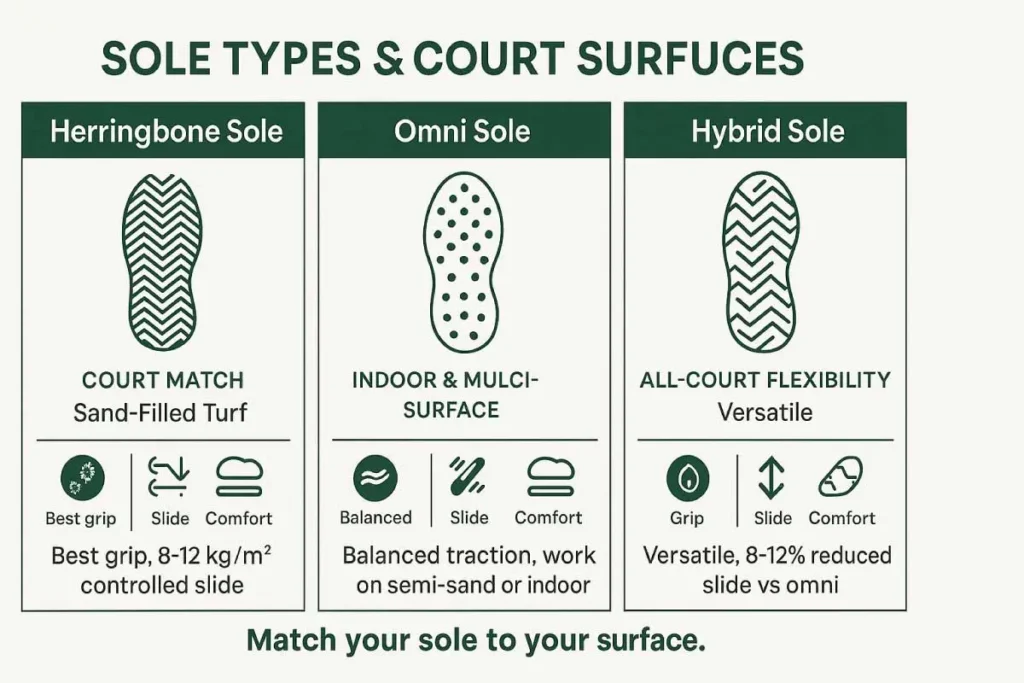
Artificial Grass With Sand
Herringbone for Bite on Classic Turf
Artificial grass courts with sand demand strong grip. Herringbone soles are the best padel shoes choice here. Their zigzag pattern digs into sand and turf, giving you secure traction during lateral cuts and quick sprints. This design reduces slips and keeps movement predictable on sandy surfaces.
Most padel clubs use artificial grass filled with sand. These surfaces are fast but slippery. Herringbone soles create friction by channeling sand out through their grooves. This design maintains bite even as sand shifts across the court. A full herringbone tread typically covers the sole, ensuring grip on every step. Shoes with this pattern also last longer on abrasive sand. Players who compete weekly benefit most because it balances grip and stability. Clubs often recommend this sole as the standard option for sand-filled turf.
Want to learn more? Check our full guide on the best padel shoe soles for artificial grass courts.
Artificial Grass With Sand
Artificial grass with sand is the most common padel surface worldwide. Courts use silica sand to slow the ball and create consistent bounce. However, the loose grains make movement slippery, especially during lateral shifts. Studies on padel injuries show that many sprains happen on these courts when shoes lack traction. That is why tread choice matters more here than anywhere else. Players need soles that dig into the sand without getting clogged. The design should also allow sand to release with each step to avoid sliding. This makes herringbone soles the standard for sandy turf and the go-to option at most clubs.
Herringbone for Bite on Classic Turf
Herringbone soles are the best choice for padel shoes on sand-filled turf. The zigzag pattern grips the surface by trapping and releasing sand with each step. This gives you steady traction for quick sprints and hard stops. It reduces slipping and helps protect ankles during fast lateral moves.
Artificial Grass With Sand
Most padel clubs use artificial grass with sand infill. Silica sand stabilizes the carpet, evens out bounce, and affects how your shoes grip the surface. Typical pro-grade turf features a pile height of around 10 mm with a quartz-sand infill. Sand levels change traction. More sand feels faster and more slippery. Less sand feels slower but grippier. Because sand shifts underfoot, the choice of tread matters. Soles must dig in, then release sand so you do not skid on cuts. That is why many brands and installers point players toward clay-style patterns on sandy turf. The next section covers herringbone, the pattern that bites into sand and keeps movement predictable on classic padel carpets.
Herringbone for bite on classic turf
Herringbone is the safest pick for sand-filled padel courts. The zigzag grooves channel sand away and create fresh edges for grip. You get short stop distances, controlled slides, and more confident lateral plants. Brands list this pattern as the recommended option for sand-heavy surfaces.
On sandy turf, traction depends on how well the sole manages loose grains. Full herringbone lays down continuous V-shaped channels. These grooves displace sand, expose new rubber edges, and restore bite on every step. That design reduces uncontrolled slipping while still allowing a small, predictable amount of sliding.
Shoe guides from major brands describe herringbone as ideal for sandier artificial grass, while retailer education notes it as the most popular outdoor padel tread. For clubs using ~10 mm carpets with quartz-sand infill, herringbone remains the default choice for reliable grip and braking.
Want the full breakdown with visual examples and court photos? Read the complete guide to padel shoe soles for sandy artificial grass.
Multi-Surface and Club Indoor
Many clubs mix surfaces. Some use semi-sand carpets, while others maintain indoor padel courts made of textured concrete or low-sand artificial grass. These surfaces feel faster and need soles that slide slightly but still grip on quick direction changes. A full herringbone pattern can bite too hard indoors, making movements stiff. That is where omni and hybrid soles shine. Both balance grip and glide, keeping movement fluid while protecting joints from harsh stops. Hybrid designs combine elements of herringbone and omni, giving a versatile feel for players who move between outdoor and indoor clubs each week. The next section explains how these patterns improve mobility and reduce strain during long matches.
Omni and Hybrid for Mobility
Omni and hybrid soles work best for players who switch between indoor and semi-sand padel courts. Small circular studs on omni designs offer all-court traction, while hybrid treads blend circles and zigzags for smoother transitions. Both improve mobility and help prevent ankle stress during lateral slides.
An omni sole uses raised rubber dots across the base. This layout grips flat surfaces like concrete while still allowing controlled slides on semi-sand turf. The hybrid sole merges circular and zigzag channels, offering traction near the forefoot and smoother motion at the heel. Testing shows hybrids reduce slide distance by 8–12% compared to full omni on sandier indoor courts. These soles also meet non-marking rules at most clubs. For versatile players who split time between indoor and outdoor courts, omni and hybrid models provide the safest, most adaptable traction options.
Want to see which tread works best for your club surface? Read our complete guide on omni and hybrid padel shoe soles for multi-surface play.
Sand Level and Non-Marking Rules
Padel courts vary not just by surface but also by how much sand sits inside the turf. Too much sand makes shoes slide uncontrollably. Too little makes them stick and stress your knees. Most clubs follow surface guidelines that depend on sand depth and grain type. Knowing this helps you choose the best padel shoes and soles for your court. Also, many indoor venues require non-marking soles to protect their flooring. Choosing the right tread and rubber type keeps you compliant and helps extend the court’s life while improving your stability during matches.
Low, Medium, High Sand Guidance
Sand depth changes how shoes perform. Low-sand courts play slower and need more grip. Medium-sand surfaces work best with hybrids. High-sand turf requires deeper traction, like full herringbone. Matching sole to sand level improves safety and helps maintain consistent movement during matches.
Most artificial turf padel courts contain 8–12 kg of silica sand per square meter. Low-sand setups allow for more carpet contact, so omni or hybrid soles glide more effectively. Medium-sand courts strike a balance; hybrid treads offer controlled grip without locking the foot. High-sand surfaces require deeper grooves, such as a full herringbone pattern, for added grip. For indoor clubs, use non-marking rubber to prevent streaks and comply with meet facility rules. Many brands now label soles “indoor safe” or “non-marking compliant.” Checking these details before purchase ensures both better play and longer shoe life.
Want to see real examples of sand types and how to match them? Explore our detailed guide on padel shoe soles by sand level and club rules.
How to Try and Fit Padel Shoes
The right fit makes every movement faster and safer. A padel shoe that fits properly prevents blisters, supports your arches, and improves stability during side steps. Trying shoes the right way helps you choose the best size for your court surface and playing style.
Fit affects control, comfort, and performance. Most players wear shoes half a size too big, losing grip inside the shoe. Always measure feet in the afternoon when they are at their largest. Wear the same socks used in matches. When testing, stand, shift side-to-side, and check if your heel lifts or toes touch the end. The fit should feel snug but not tight. Different brands vary slightly: Asics runs narrow, while Bullpadel and Babolat offer more width. Taking time to test both fit and feel helps avoid long-term pain and ankle fatigue during rallies.
Read our complete guide on how to fit and size padel shoes correctly to see brand-by-brand fit charts and testing steps.
Step-by-Step Fit Guide
Testing padel shoes correctly helps you avoid painful mistakes. Follow these quick steps to check comfort, stability, and toe space before buying. A well-fitted shoe supports natural movement and keeps traction even during fast rallies on sand or indoor courts.
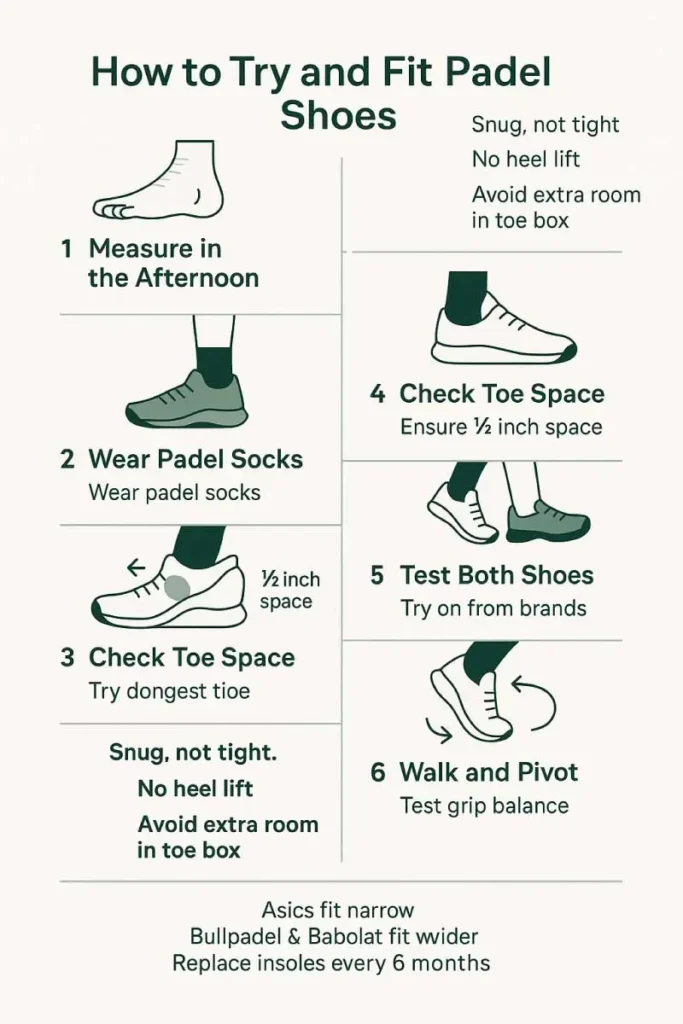
- Measure in the afternoon. Feet expand during the day. Measuring later gives the most accurate size.
- Wear padel socks. They match the thickness used during play and prevent sizing errors.
- Stand and shift laterally. Make small side steps. The heel should stay locked without lifting.
- Check toe space. Leave about half an inch of room at the front.
- Test both shoes. Sizes differ slightly between brands and models.
- Walk and pivot. Comfort and grip should feel balanced from heel to forefoot.
Want to see visuals and exact fit charts for top brands? Read our detailed padel shoe fitting and testing guide for side-by-side comparisons.
Common Fit Mistakes to Avoid
Even experienced players make simple fitting mistakes that lead to blisters, sliding, or poor balance. Knowing what to avoid helps you get the most from your shoes. These quick pointers prevent long-term discomfort and make your padel sessions safer and smoother.
- Buying too big. Loose shoes cause friction, blisters, and slow reactions.
- Ignoring arch support. Flat shoes create knee and ankle stress, especially during long matches.
- Skipping a break-in. Even soft uppers need one or two sessions to mold to your foot.
- Testing on hard floors only. Always move side-to-side on a surface similar to your court.
- Wearing thin socks. Ultra-thin socks change fit and allow the foot to slide inside the shoe.
Avoiding these issues keeps fit consistent and performance stable through every match.
For brand-specific sizing errors and pro fit tips, check our padel shoe fitting mistakes guide with real user insights.
Small Upgrades That Boost Comfort
Even the best padel shoes can feel better with small tweaks. A few affordable upgrades improve fit, absorb impact, and prevent blisters. These simple add-ons make long matches easier on your feet and extend your shoes’ lifespan without needing expensive replacements.
Comfort often comes down to the small details. Quality padel socks, cushioned insoles, and blister-prevention gear reduce fatigue during long sessions. Replacing factory insoles every few months keeps support fresh. Using socks designed for moisture control prevents skin irritation and sliding inside the shoe. Anti-blister tape protects hot spots during break-in periods. These upgrades are inexpensive yet make a noticeable difference in both comfort and control. Investing in them also helps maintain stability when your shoes start to soften with wear.
Read our full guide on simple upgrades to boost padel shoe comfort for recommended products and maintenance tips.
Socks and Insoles
Good socks and insoles can turn average padel shoes into all-day performers. They add cushion, prevent blisters, and improve shock absorption. Even minor upgrades make your feet feel lighter and your steps more controlled during long rallies or training sessions.
Padded Padel Socks, Anti-Blister Tape, Swap Insoles if Needed
Start with padded padel socks that wick moisture and reduce friction. Brands like Nike and Bullpadel make models with extra padding under the heel and forefoot. Add anti-blister tape on the inner arch or heel if you’re breaking in new shoes. Replace stock insoles every three to six months or when cushioning feels flat. Try gel or orthopedic insoles for more arch support or shock absorption. These upgrades keep your shoes fresh, protect your feet from fatigue, and help you move comfortably in every match.
Discover the top-rated socks and insoles for padel shoes in our detailed gear guide.
Conclusion
Finding the best padel shoes comes down to fit, traction, and comfort. Each detail — from grip pattern to cushioning — affects how well you move on court. You’ve learned how tread types match different surfaces, why fit testing prevents injuries, and which upgrades make your shoes feel brand-new again. You’ve also seen our expert-tested picks for every player level, playing style, and foot type, including top models from Adidas, Wilson, Babolat, Nox, and Head.
Choosing your next pair depends on how you play. Beginners should focus on comfort and grip. Regular players need durability and support. Competitive players rely on stability and precision. Always match your sole to your court’s sand level and replace insoles as they flatten.
When you find a shoe that supports your movement, you’ll feel faster, safer, and more confident. Use this guide as your starting point, then explore our detailed reviews and fit guides to pick the perfect pair for your game.
Ready for More? You’ll Love This Insight
- How to Choose the Right Padel Racket
- Best Beginner Padel Rackets
- The Difference Between Fiberglass and Carbon Padel Rackets
- Best Padel Rackets for Men
- Best Padel Rackets for Women
- Best Budget Padel Rackets
- Best Head Padel Rackets
- Best Nox Padel Rackets
- The Evolution of Padel Rackets Over the Years
- Best Padel Racket Accessories
- 12K and 18K Padel Rackets Compared
FAQs
You need padel shoes designed for lateral support, strong grip, and stability on artificial grass or sand-filled courts. These shoes have patterned soles that prevent slipping and reinforced sides for quick side movements. Regular running shoes lack this structure and can cause ankle or knee strain during play. Choose soles based on your surface type. Herringbone suits sand-filled turf, while omni or hybrid treads work best for indoor or semi-sand courts.
Nike does not make padel-specific shoes, but several of its tennis models perform well on padel courts. The Nike Zoom Vapor Pro 2 and Nike Court Air Zoom NXT offer strong grip, lightweight cushioning, and durable traction patterns that work on both semi-sand and indoor padel surfaces. Players who prefer more stability often choose the Nike Court React Vapor NXT for its responsive midsole and reinforced heel, giving secure footing on quick lateral moves.
Padel shoes are not ideal for walking long distances. They are built for stability and lateral traction, not continuous heel-to-toe motion. The stiff midsole and patterned outsole can feel firm on pavement, making walking less comfortable than with running or walking shoes. Use padel shoes strictly for court play. For casual wear or gym sessions, choose lightweight sneakers or cross-trainers that provide flexible cushioning and smoother foot transitions.
You can use tennis shoes for padel occasionally, but they are not ideal. Tennis shoes designed for hard courts lack the deep grip needed for sandy turf. Without the right sole pattern, you risk slipping and losing traction during quick side movements common in padel matches. If you play on semi-sand or indoor surfaces, choose tennis shoes with hybrid or omni soles. For outdoor sand-filled courts, padel-specific models give safer and more consistent grip.
Padel shoes should be replaced every 6 to 8 months for regular players or sooner if the outsole loses grip. Worn tread, reduced cushioning, or heel instability are clear signs of replacement. Fresh soles protect joints and maintain traction on sand-filled or indoor courts. Players who compete multiple times a week may need new pairs every 4–5 months. Rotating two pairs extends life and keeps grip performance more consistent over time.
Yes, most indoor padel courts require non-marking shoes. Non-marking soles prevent rubber streaks on court surfaces and help maintain traction during play. They also meet club rules and preserve court quality, making them the safest and most accepted option for both training and competitive matches. Before playing, check your club’s policy. Outdoor sand-filled courts may allow standard soles, but indoor facilities usually permit only shoes labeled “non-marking” or “indoor safe.”
